Clifford Browder's Blog, page 53
May 19, 2013
61. Jim Fisk, part 1: Prince Erie
Here begins the Saga of Jim Fisk, a series of posts relating the later adventures and misadventures of the nineteenth century's most colorful robber baron. We last saw him in post #46, where, at the end of the Great Erie War, he and his pal Jay Gould inherited the Erie Railway, its coffers empty, its track two streaks of rust. He immediately moved the Erie offices into an opera house that he had just bought and renamed for himself: another Erie first -- a railroad in an opera house. What follows is slightly fictionalized, being drawn from my unpublished fiction, but it adheres closely to historical fact, and most of the dialogue is drawn from contemporary sources.
* * * * * * *
It was a marriage of opposites: Jim Fisk all grin and girth, a ruddy-faced glad-hander in check trousers and an orange or red vest, fingers studded with rings, punning and chortling to chorus girls, clerks, and reporters, the observed of all observers about whom gossip gushed; and Jay Gould, a feather of a man, puny-chested, skinny-limbed, with big dark silent eyes under a soft felt hat, and the pallor of a back-shop clerk: a thin talker, a dainty eater, gray-suited, his thoughts like quiet mice. Together, they ran the Erie Railway. Both stole; they called it “financiering.”
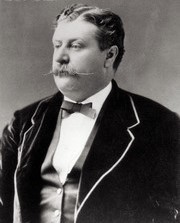 Fisk in full regalia, hair pomaded, mustache
Fisk in full regalia, hair pomaded, mustache waxed to a rapier tip.
Jim Fisk was a joyous thief, loose as change, his mind all flash and froth. To seize a little upstate railroad, he bought stock, fired off a volley of injunctions, and sent a trainload of Erie employees armed with shovels and wrenches against a trainload of workers loyal to the management. They met head on, engine to engine, whistles screeching, with a jolt, a hubbub of oaths. Fists flew, clubs thumped, skulls were cracked and gashed; outnumbered, the Erie men fled. Quipped Fisk, when informed by wire at a safe remove, “Nothing is lost save honor!”
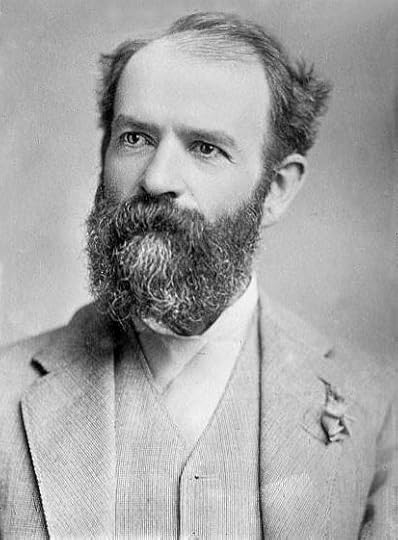 Some thought he looked a bit sinister,
Some thought he looked a bit sinister, even devilish. Jay Gould was a whispery thief immune to the bite of conscience, passionless as dawn. To meet him was to walk in river mist or a soft frost. He sat at his desk for hours, his brain tensile as a gymnast, felted as a stalking cat. Nothing so pleased him as submarine flowers of intellect, faceted crystals of thought. His mind hatched schemes so daring that even Jim Fisk gasped. When Jay Gould’s schemes fired up Jim Fisk’s bounce, Wall Street popped and sizzled.
When they locked up all the greenbacks in sight, markets splintered into panic; from all sides, insults and oaths glanced off their iron-plated egos. When they cornered Dan Drew in Erie and he came to them owing them millions, pleaded through the night (into the Sabbath – for a churchgoing Methodist, a sacrilege), huffed up, and puckered down, waxing hot, cold, hot in a web of pleas and wiles, they were adamant; and when, shoring up his pride, he said good night in a choked voice and scuffed out into the dawn, they guffawed.
Those seeking access to Jim Fisk in his Opera House office – money men, journalists, humble suppliants – entered a marble-paved lobby through portals guarded discreetly by a squad of bruisers whose job it was to keep out process servers: Fisk’s minions, the very sight of whom made Jay Gould wince. From there visitors mounted a grandiose staircase to traverse a huge hall frescoed with flowers and vines, among which nestled naked cupids and nymphs, then passed through carved oak doors into an anteroom staffed with ushers where, if approved, they were waved through a bronze gate into another great hall with frescoed walls and ceiling.
There, on a leather-cushioned throne behind a mammoth black walnut desk, sat Prince Erie, surrounded by mirrors and silk hangings, with sixteen buzzers close at hand to summon any employee in the sixteen departments of the Erie offices. While male secretaries scribbled letters that he dictated three at a time, clerks and messengers scurried to do his bidding, their laughter at his constant jokes bubbling upward under a cerulean ceiling splashed with ERIE in gold. Amid this splendor and bustle, visitors were received, schemes conceived, interviews granted, acts of random charity performed.
Such magnificence masked the frantic vibrations and rumble of a steam-operated printing press buried deep in the bowels of the basement, whereby, through what director Fisk termed “freedom of the press,” blank sheets of paper were converted into certificates of Erie stock. Thrown in abundance on the market, this watered stock had brought instant profits to Messrs. Fisk and Gould, while depressing the stock’s price to the nethermost depths. “When Erie declares a dividend,” went a Wall Street saying, “icicles will form in hell.” Though headquartered in a marble palace, the railroad was pinched for funds.
 He didn't look quite so stern and imposing,
He didn't look quite so stern and imposing,when Fisk barged into his bedroom. Jim Fisk decided that Erie’s finances required his personal attention. Lugging a carpetbag and with a lawyer in tow, he barged into Commodore Vanderbilt’s red-brick residence on Washington Square to confront the richest man in the nation. Brushing past a servant, he and the lawyer bounded up the stairs and burst into the Commodore’s bedroom. The titan was sitting on the edge of his bed in a dressing gown, one slipper on, one off.
“Commodore,” said Fisk, “I’m here on behalf of the shareholders of the Erie Railway, to collect the money you swindled us out of in that settlement last July. Now here” (he opened the carpetbag) “are fifty thousand shares that you made us take off your hands at 70, which comes to three and a half million. And we want another million back that was paid you to cover your losses. So please make out a check for four and a half million dollars, with interest from July 11.”
Astonished, Old Eighty Millions reddened with rage, all the more so in that the stock was now selling for 40. “I hain’t sold no stock to Erie,” he lied, “nor received no million bonus! I hain’t payin’ you one cent!”
Hot words followed, with Fisk’s demands splintering against the iron of the old man’s will.
“Well then,” said Fisk, scooping the stock certificates back into the carpetbag, “We’ll sue.” With his lawyer he headed for the door.
Thundered Vanderbilt, “Sue and be damned!”
In the lawsuit that followed, Jim Fisk testified before the august wisdom of Justice George G. Barnard about his first meeting with the Commodore during the recent Erie war. Questioned by his attorney, he assumed a whimsical expression that had the courtroom smiling from the start.
“Sometime after our little vacation in New Jersey” (laughter), “I had an interview with the Commodore. It was pretty warm – not the interview but the weather.” (Laughter.) “I remember, because the Commodore was a bit profane about it.” (Great laughter.) “It shocked me to hear him talk that way.” (Continued laughter.)
“Did you call on Mr. Vanderbilt?”
“I think I did.”
“Do you know that you did?”
“Most undoubtedly.” (Laughter.) “The recollection is vivid and the memory green.” (Laughter.)
“What happened?”
“The Commodore received me with the most distinguished courtesy and overwhelmed me with a perfect ambulance of good wishes for my health.” (Laughter.) “Then we came plump up to the matter at hand, and we had it out. He said he couldn’t make sense of us – our outfit had no head nor tail, and old Drew was no better than a batter pudding.” (Great laughter.) “It distressed me to hear him say that, but upon reflection I said that I agreed.” (Continued laughter.) “While we were talking, I was looking at his shoes. They had four buckles. I thought to myself, if men like this have shoes like them, I must get me a pair.” (Hilarious laughter.)
During his whole testimony laughter rippled through the courtroom, cresting at times in great waves, until the judge himself was wiping tears from his eyes.
Months later, when Vanderbilt testified, he provoked no ripples of mirth. He denied heroically, lied with grandeur, or announced defiantly, “Them’s are things as I keeps to myself.” Called in turn as a witness, Uncle Daniel, sweet-tempered throughout and brimming with injured innocence, evinced pits of ignorance and bottomless chasms of oblivion. The case promised to drag on for years.
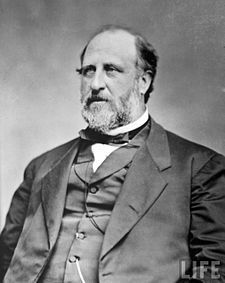 Yes, his name rhymes "greed," but
Yes, his name rhymes "greed," butlet's not push it. Jim Fisk decided that Erie’s lack of political connections required his personal attention. He went to see Boss Tweed in the Boss’s Duane Street office.
“What can I do for you, Mr. Fisk?” asked the massive Tweed.
“Boss, I’d like to talk to you about a railroad.”
The Boss grinned broadly. “Always glad to talk about a railroad.”
What exactly the two men said in the Boss’s inner office no one ever knew, but when they emerged a half hour later, they were basking in a warmth of newfound friendship that soon extended to dinners at Delmonico’s. Fisk savored the aroma of power that wafted off the Boss, while the Boss appreciated Fisk’s bonhomie, his zest for keen living and astute financiering unvexed by petty qualms. When their camaraderie expanded to include intimate suppers at Josie Mansfield’s brownstone, Tweed found Fisk’s ladylove to be a charming and most attentive hostess, while Josie, entertaining the city’s grand mogul and his cronies, was thrilled to the cockles of her heart. At the next annual election, William Marcy Tweed and City Chamberlain Peter “Brains” Sweeny joined the board of the Erie Railway.
When Judge George G. Barnard, once the wrathful nemesis of Erie, learned of Boss Tweed’s growing partiality for Jim Fisk and Jay Gould, his hard feelings toward the duo softened like a warmed lump of wax. Meeting them socially through Tweed, he found them both to be perfectly delightful fellows, and discovered that he shared specifically with Fisk (Gould being a hearth-clinging family man) the delights of good liquor, fine cigars, and the teasingly shapely legs of a cancan. Thereafter his glistening black locks, ruffled shirtfront, and diamond sleeve buttons were seen increasingly at Josie’s, where he dropped in for poker and champagne. Fisk and Barnard relished in each other a heroic risk taker immune to the buzz of fools.
This new friendship showered benefits on all. When Erie stockholders, outraged by the company’s dubious financing and perennial lack of a dividend, leagued together to enjoin Fisk and Gould and oust them from control, the duo obtained from their favorite magistrate (now a recipient of Erie stock) an injunction enjoining the enjoiners that left the two directors with their railroad snug as rats in cheese. Thereafter Fisk sent Barnard two stuffed owls symbolic of his double wisdom, and the judge’s name was blazoned on an Erie locomotive in gold.
Jim Fisk decided that the state of theater in Gotham required his personal attention. No sooner installed in the Opera House, he leased two other theaters as well, hired directors and performers, and overnight became the biggest theatrical producer in the city. Having a go at Shakespeare one month and at farce or opera the next, he piled failure upon failure until he found a winning formula at last: The Twelve Temptations, a splashy musical with a real waterfall, Spanish dancers, an Egyptian ballet, and one hundred tantalizing females kicking high in a cancan that at once became the talk of the town. He advertised like crazy; multitudes flocked.
THE DEMON CAN-CANReceived Nightly with Wild EnthusiasmTERPSICHOREAN AEROSTATICS-- The Mystery Still UnsolvedTHE EGYPTIAN BALLET-- The Most Novel of NoveltiesTHE GRANDTRANSFORMATION SCENEThe Wonder of Wonders100 BEAUTIFUL YOUNG LADIESContains Nothing Objectionable
Flaunting his shirtfront diamond, producer Fisk posted himself in the lobby before curtain time to fling a jovial greeting at Boss Tweed, Judge Barnard, dapper Mayor Oakey Hall, and lesser luminaries and friends. During intermissions he hopped from box to box or mixed with tipplers at the bar, giving of his abundant good cheer to all. At the Opera House Miss Mansfield had a box of her own just above his, though as a sop to propriety he forbore to visit it, being well aware that select members of the audience were craning their necks to glimpse the lady in question and whoever cared to be seen in her company. At the final curtain he took a bow with the cast.
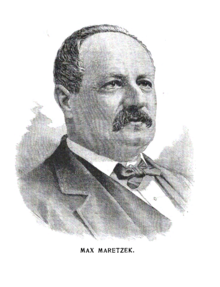 So taken was impresario Fisk with Offenbach, that he sent the respected Austrian-born director Max Maretzek to Paris to lure the master of light opera to New York. Maretzek returned not with Offenbach, who declined, but with a bevy of renowned female performers to spice up the Opera House offerings. From then on manager Fisk was often seen driving in the Park with such stunning beauties as Mlle Irma and Céline Montaland, if not a whole troop of dancers. Rumors soon circulated of naughty doings in the wings of the Opera House, then tales of nightly orgies in his frescoed office, with Fisk cavorting among half-naked dancers amid a catered spread of caviar and champagne. How Prince Erie could find time for such escapades and still manage or mismanage a railroad, and keep Miss Mansfield reasonably content, no one quite explained.
So taken was impresario Fisk with Offenbach, that he sent the respected Austrian-born director Max Maretzek to Paris to lure the master of light opera to New York. Maretzek returned not with Offenbach, who declined, but with a bevy of renowned female performers to spice up the Opera House offerings. From then on manager Fisk was often seen driving in the Park with such stunning beauties as Mlle Irma and Céline Montaland, if not a whole troop of dancers. Rumors soon circulated of naughty doings in the wings of the Opera House, then tales of nightly orgies in his frescoed office, with Fisk cavorting among half-naked dancers amid a catered spread of caviar and champagne. How Prince Erie could find time for such escapades and still manage or mismanage a railroad, and keep Miss Mansfield reasonably content, no one quite explained.A scourge of old-fogey ideas, impresario Fisk barged into rehearsals to critique the scenery, calm a prima donna’s tantrum, joke with stagehands, wink at a soubrette, and offer the director some pointers based on his own vast theatrical experience (one season as a circus roustabout handling hyenas and kangaroos in his teens). Directors resented these intrusions; stagehands and performers relished them. Once, hearing that Max Maretzek, against his expressed wishes, had agreed to conduct a concert at a rival theater, Fisk burst into a rehearsal in a rage, assailing the director with a barrage of insults. Maretzek was known for his violent personality, dictatorial and intransigent. Incensed, he strode down from the podium and aimed a punch at Fisk’s nose. Fisk parried, and the two grappled and fell to the floor in a tussle, Fisk’s bulky torso ending up on top, while divas and dancers screamed. Stagehands broke it up; the two combatants retired in high dither, Fisk with a torn shirtfront, and Maretzek with a darkened eye. The director, threatening a lawsuit, quit.
Soon after this a shareholder brought suit against Prince Erie, demanding his ouster for bringing females of bad repute into the corporation’s offices, alleging “that the frequenting of the building by impressionable young clerks and by opera and theater women at the same time, with the tread of ballet girls and echoes of operas and songs, and all sorts of string and wind instruments, resounding in said building, is demoralizing to said young clerks, destructive of the company’s interests, and without parallel in railroad history.” Informed of the suit, Fisk grinned.
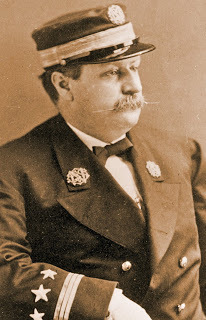 Admiral Fisk Jim Fisk decided that navigation on Long Island Sound required his personal attention. Having acquired the Narragansett Steamboat Company, running boats to Fall River, Massachusetts, he refurbished his boats with new carpets, plush upholstery, bronze statues, brass spittoons, splashes of gilt, and a band to serenade the passengers en route. Also a canary in every cabin, since he loved canaries and shunned silence and solitude. His boats, he deemed, were now more than a match for Dan Drew’s floating palaces on the Hudson, which boasted neither bands nor canaries.
Admiral Fisk Jim Fisk decided that navigation on Long Island Sound required his personal attention. Having acquired the Narragansett Steamboat Company, running boats to Fall River, Massachusetts, he refurbished his boats with new carpets, plush upholstery, bronze statues, brass spittoons, splashes of gilt, and a band to serenade the passengers en route. Also a canary in every cabin, since he loved canaries and shunned silence and solitude. His boats, he deemed, were now more than a match for Dan Drew’s floating palaces on the Hudson, which boasted neither bands nor canaries.A half hour before departure Fisk would appear on the dock in a blue naval uniform specially designed by his tailor with gold buttons and braid, and three gold stars on the sleeves – an outfit identical with the dress uniform of a United States admiral, except for lavender kid gloves and a shirtfront sparkler. Thus attired, he stood by the gangplank uttering nonsensical commands to the crew that impressed boarding passengers but by agreement were otherwise ignored, his nautical knowledge being nil. Soon afterward he hurried ashore to watch the boat depart, flags fluttering and band blaring, and receive the captain’s salute.
 Known to his readers as Uncle Horace. One afternoon an older man in spectacles and with a fringe of whiskers, wearing floppy trousers and a wide-brimmed, low-crowned hat, shuffled up the gangplank. In this rumpled seeming rustic Fisk recognized Horace Greeley, the most influential editor in the nation, whose New York Tribune had spiked the Erie management on many an editorial prong.
Known to his readers as Uncle Horace. One afternoon an older man in spectacles and with a fringe of whiskers, wearing floppy trousers and a wide-brimmed, low-crowned hat, shuffled up the gangplank. In this rumpled seeming rustic Fisk recognized Horace Greeley, the most influential editor in the nation, whose New York Tribune had spiked the Erie management on many an editorial prong.“Welcome, Mr. Greeley,” he said warmly, reaching to take the editor’s carpetbag. “Come right on board. We’ll be off directly.”
Greeley’s pink moon face registered surprise; he grabbed his carpetbag back.
“My name is Fisk,” the admiral announced with a grin. “You’ve probably heard of me.”
Greeley looked puzzled, then nodded. “Oh yes,” came the high-pitched, squeaky voice. “You were an ensign in the North Atlantic blockading squadron in 1864. I wrote about you once.”
Fisk laughed merrily. “No, Mr. Greeley, I’m James Fisk, Jr., of the Erie Railway. I’m indebted to you for several editorial compliments.”
Owl-faced, Greeley eyed him through his spectacles, then announced in resonant tones, “Long ago I invested five thousand dollars in the construction of that line and to date have an eighty-percent loss. That railroad is grossly mismanaged. It should pay a handsome dividend. It runs through a rich agricultural region and – ”
Bystanders had cocked an ear, but the rest of Greeley’s tirade was lost, for at a signal from Fisk the nearby band saluted Greeley with strident blasts of “Hail to the Chief.”
Not all criticism could be muffled with a blast from a band. Erie’s workers were underpaid or sometimes not paid at all. At a machine shop in Jersey a reporter interviewed one of them, who exclaimed bitterly: “This road’s close to bust! How could it not be, when so much money goes for wine, women, and opera houses full of actresses and dancing girls? They tell me Fisk went driving in the Park the other day with a woman whose hair was full of diamonds. Diamonds, by God! We work twelve hours a day for a lousy dollar and sixty-two cents. No wonder there’s talk of a strike.”
Word of this reached the Erie offices. As both well knew, Jay Gould couldn’t talk to a gang of workers if his life depended on it, so Prince Erie decided to give the matter his personal attention. Visiting the machine shop where discontent was said to be keen, he went wearing a jaunty velvet cap and a sparkler, greeted the men heartily, ignored their sullen silence, mounted a crate to address them. He was plain Jim Fisk, he told them, an angel or a devil, since the papers had called him both. But he and Mr. Gould were spending millions on Erie's cars, engines, roadbed, and rails, so as to improve its service. As for the workers, their homes might be humble, but when their daily toil was over and they straddled the legs of their supper table, they could enjoy the evening with their family, whereas he'd spent many a night in his office studying how to whistle up a hundred million dollars by noon the next day. And he was doing it for them, because their interests were the same. And if any of them should ever come to New York, and he could help them, they should come see him in his office. With their help, he and Mr. Gould were going to make Erie the greatest corporation on the continent. "So good-bye and God bless you!"
Growing shouts of approval had seasoned his address; now, loud cheers accompanied his departure. The men returned to their jobs convinced that plain Jim Fisk was the best friend a workingman could have.
The next day he was driving six-in-hand in the Park in a turnout lined with gold cloth, three white horses paired with three black, entertaining Mlle Irma and Céline Montaland, their bright scarves plucked by the breeze; every eye in the Park was on him.
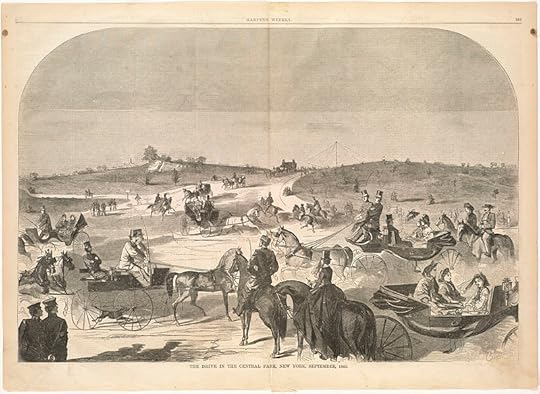 The Drive in the Central Park. Here Prince Erie loved to cavort, driving six-in-hand
The Drive in the Central Park. Here Prince Erie loved to cavort, driving six-in-handwith a bevy of dancers.
Follow-up to last week's post on fascism: From the New York Times of last Thursday, May 16:
BIG BANKS GETBREAK IN RULESLIMITING RISKS
"Under pressure from Wall Street lobbyists, federal regulators have agreed to soften a rule intended to rein in the banking industry's domination of a risky market.
"The changes to the rule ... could effectively empower a few banks to continue controlling the derivatives market, a main culprit in the financial crisis."
Neither the banks nor the regulators have learned anything. No further comment is necessary.
A solution for WBAI? As always, but now more desperately than ever, WBAI needs money. So imagine my surprise when, tuning in the other day during the current fund-raising marathon, I heard them offering as a premium two CDs entitled "Six Steps to Wealth." At first I thought it was health that they were offering, but closer listening confirmed that it was wealth. WBAI, that bastion of anticapitalism, was offering "Six Steps to Wealth" for a mere $120! The program host praised to the firmament the author of said CDs, one Dr. John Demartini, who has toiled nobly for 38 years, so he himself declares, in the cause of human betterment. Samples of the material were played, in which Dr. Demartini explained that the only obstacle between yourself and the wealth you aspire to is ... yourself! To redeem us from this predicament, he offers his six-step program. But he also has the key to countless other problems, and to those willing to pledge a mere $360 a "superpac" of his wisdom will be sent, wisdom that will change your life. That I am leery of martinis in any form has already been made clear in post #47, Discovering New York (February 2013), so I of course declined to accept these generous offers. But I had an epiphany: Dr. Demartini offers a six-step program to wealth, and WBAI desperately needs exactly that. The obvious solution: all those running the station should themselves invest $120 (or $360!) to overcome whatever it is that keeps WBAI from realizing its financial potential. What could be more clear? I truly hope that the station will embrace my suggestion. No more fund-raising marathons -- O joy! O bliss! O ecstasy!
Coming attractions: Next week, Abnormal and Paranormal Adventures (saving the world through a cosmic jack-off, floating in space and monoxide, coming back from immensities of light). Also: more Jim Fisk (the great gold corner of 1869), Who is a hero? (Obama? the Dalai Lama? Bradley Manning?), Farewells (both tearful and nasty), the Magnificence and Insolence of Trees (I love those guys). And in the works: Go Ahead: The Mania of Progress (America's favorite obsession, what it has done both for and to us). The favorite post to date: Man/Boy Love (#43, January 2013), though last week's post on fascism got a record 118 one-day views on Sunday, and another 85 on Tuesday.
(c) 2013 Clifford Browder
Published on May 19, 2013 04:38
May 12, 2013
60. Is America Becoming a Fascist State?
The words fascism and fascist get used very freely, and often irresponsibly; we all do it. George Orwell once remarked that he had heard them applied to shopkeepers, farmers, fox hunting, bull fighting, Kipling, Gandhi, homosexuality, astrology, women, and dogs. But on station WBAI they are used very seriously, when any number of voices insist that this country either is already a fascist state or is fast becoming one. (Veteran viewers of this blog know that WBAI is the station I love to love and hate to hate. See post #16, July 2012, and #50, March 2013). Most Americans would probably dismiss these assertions as irresponsible, but the examples cited and the people interviewed are impressive. So here is my take on the subject, the reaction of someone with no expertise on the topic, just the random reflections of an ordinary -- a very ordinary -- citizen.
When I hear mention of fascism, these thoughts come to mind:
A charismatic right-wing leader who requires unquestioning obedience from the populace.Intense nationalism, patriotic fervor, mass rallies.The state is supreme; the individual is subordinate.Great emphasis on the police and the military.Contempt for democracy; suppression of dissent.Alliance with corporate elites.Aggressive wars. Now let's have a look at these notions, one by one.
1. For examples of a charismatic right-wing leader, we know where to look.
 German Federal Archives
German Federal Archives
 German Federal Archives
German Federal Archives But do we have such a leader here? No, since whatever you think of him, Obama is no Hitler or Mussolini. He's a gifted speaker, but he doesn't mesmerize the way they did, he doesn't command the blind, feverish loyalty of multitudes. (Not that charismatic leaders have to be evil. On the contrary, think of FDR and Teddy Roosevelt; both had their faults, but both accomplished a lot, and neither should be called evil.)
2. Intense nationalism? In the past yes. At the outset of the Civil War, no young man in the North who was not in uniform could hope to impress a young lady. And my parents have told me how, in Indianapolis during World War I, a young man whom they knew took to the alleys and avoided the streets, because he had not been accepted for military service. But as I recall, we were less blindly patriotic during World War II, and in the undeclared wars since then -- all of them controversial -- the flame of patriotism has often sputtered and come close to flickering out. But it is good to remember words of (or attributed to) Sinclair Lewis in the 1930s: "When fascism comes to America, it will be wrapped in a flag and carrying a cross." But consider this ...
 Nuremberg rally, 1938.
Nuremberg rally, 1938.German Federal Archives
No, nothing like it here. Mass rallies for civil rights, for the environment, for all kinds of good and noble causes, but nothing so organized, so military.
Note on mass rallies: Back in the 1930s -- yes, I was alive back then -- I heard an American, probably a journalist and certainly no Nazi, describe one of the Nuremberg rallies. Inside the great hall all was quiet, but with great anticipation. Then, in the distance, came a sound of marching feet. Slowly, as it got nearer and nearer, louder and louder, the anticipation became intense. Then, suddenly, the doors flew open and in came masses of troops, banners, swastikas, and at the head of it all, Adolf Hitler. The spectators leaped to their feet and shouted "Heil Hitler!" And what was the American, a detached outsider, doing? Like everyone else, he was on his feet shouting, "Heil Hitler!"
3. The state is supreme; the individual is subordinate. Here, the plot thickens. Yes, we have the Bill of Rights (how many of us really know its content?), which are meant to protect each of us from tyranny, and they are supposed to be absolute, not subject to change, and in this regard, since democracy means putting everything to a vote and letting the majority prevail, they are undemocratic. But, being stated in general terms, they are subject to interpretation, and thereby hangs a tale. In fact, lots of tales.
You think your home is your castle? Are you aware that, in the recent brouhaha in Watertown, SWAT teams ordered people out of their homes at gunpoint, the residents' hands on their heads, and sent them down the street to be frisked by police? This was not a case of "hot pursuit," where a fugitive is tracked to a private home, but a suspension of the Fourth Amendment protection against unreasonable searches and seizures. Mainstream media affirmed that the house-to-house searches were done with the consent of the residents, but this wasn't necessarily the case. In all but name, Watertown was under martial law.
Of course these searches didn't last long, and the residents were allowed to return. Owning your own home is a good part of the American dream, is it not? And one's ownership is surely secure. No, it is not. Something called the power of eminent domain allows the state to seize private property and make public use of it. Presumably, the owner will receive fair compensation, but the confiscation cannot be refused. The property seized is usually used for public utilities, highways and railroads, and public parks. But in 2005 the Supreme Court decision in Kelo v. City of New London, 545 U.S. 469, ruled that the city of New London, Connecticut, could seize private property and transfer it to a private developer solely for the purpose of increasing municipal revenues. This was highly controversial, and several states have since ruled to disallow such confiscations under their state constitutions. Ironically, the redevelopment project proved a failure, and nothing to date has been built on the appropriated land. But an ominous precedent has been set: private property can be seized, even if no public use of it is anticipated.
 A doctor injecting a patient with a placebo
A doctor injecting a patient with a placeboduring the Tuskegee syphilis experiment. Just as ominous is the readiness of government agencies, the military, and the scientific community to use the public as guinea pigs -- not occasionally but repeatedly, as can now be documented and proven. The Tuskegee syphilis experiment of 1932-72 is perhaps the most notorious case, where the U.S. Public Health Service treated 400 impoverished black men in the South over time, but didn't tell them they had syphilis and didn't treat them for it, even when penicillin became available, since the point of the study was to observe the effects of syphilis on the human body. By the end of the study 28 had died of syphilis, 100 more were dead of related complications, 40 wives had been infected, and 19 of their children were born with congenital syphilis. The study was shut down only when it became known to the press in 1972, and the public protested vehemently.
But there have been many other cases as well. In 1950 the U.S. Navy used airplanes to simulate a biological warfare attack by spraying a presumably harmless bacteria over San Francisco, causing many citizens to contract pneumonia-like illnesses and one victim to die of it. In 1956-57 the U.S. Army conducted biological warfare experiments, releasing millions of infected mosquitoes over Savannah, Georgia, and Avon Park, Florida, causing hundreds of residents to contract fevers, respiratory problems, stillbirths, encephalitis, and typhoid; researchers, pretending to be public health workers, photographed the victims and performed medical tests on them. And so on and so on.
Of course all that occurred at a far remove from New York City and its vicinity. But from the 1950s to 1972 mentally handicapped children at the Willowbrook State School on Staten Island, in research to develop a vaccine, were intentionally infected with viral hepatitis when they were fed an extract made from the feces of patients already infected with the disease. In 1966 the U.S. Army released a harmless bacillus in the tunnels of the New York City subway system, so as to study the vulnerability of subway passengers to a covert attack with biological agents. And in 1962 Dr. Chester M. Southam injected 22 elderly patients at the Jewish Chronic Disease Hospital in Brooklyn with live cancer cells, so as to study how healthy human bodies fight the invasion of malignant cells. When this came to light, the New York State medical licensing board placed Southam on probation for a year; two years later he was elected vice president of the American Cancer Society.
In none of these experiments had the subjects given their voluntary and informed consent. The subjects of these and other experiments were poor blacks, mentally disabled children, inmates, military personnel, newborn babies, and the terminally ill -- in other words, the most vulnerable of the population, those least able to withhold consent or register a complaint afterward. In every instance one is struck by how easily those in authority, whether civilian or military, become desensitized, dehumanized. We have condemned such human experimentation by our enemies -- the Nazis and the Japanese in particular -- yet we ourselves have repeatedly done the same. The state -- the military, the public health authorities, the scientific community -- are indeed supreme, and the individual, as exemplified by the victims of these studies, is simply material to be experimented on. Nascent fascism indeed! What put a stop to these experiments? Exposure by the press, provoking a public outcry. Are more such experiments being carried out on someone now? Who knows? But to date, I know of no one being indicted or convicted for participating in such experiments.
Source note: You may well ask, what documentation is there for these instances of unethical experimentation on humans? The answer: plenty! In the Wikipedia article on the subject there are 168 footnotes citing sources, followed by an extensive bibliography on the subject. For verification, feel free to check out that article and numerous blogs on the subject. You'll find out more than you want to know.
4. The police and military are emphasized. The account of the Watertown searches should give one pause for thought. SWAT (Special Weapons and Tactics) teams are teams that use military weapons and specialized tactics in high-risk operations beyond the capacity of the regular police. They carry submachine guns, assault rifles, riot control agents, stun grenades, and the like, and are used for hostage rescue, riot control, and counterterrorist operations. Clearly, they represent the growing militarization of the police.
 Our friend or enemy? Surely they wouldn't be used for anything else, now would they? Unfortunately, precedent suggests otherwise. In 1987 some 25 armed FDA agents and U.S. marshals burst through the glass doors of the Life Extension Foundation in Fort Lauderdale with guns drawn. Employees were lined up against the wall and searched. Products, files, newsletters, and documents were confiscated, and computers and telephones ripped from the wall. Furthermore, the FDA filed 56 criminal charges against the Foundation's two top officers -- charges that the accused fought vigorously until, years later, they were dismissed by a federal judge.
Our friend or enemy? Surely they wouldn't be used for anything else, now would they? Unfortunately, precedent suggests otherwise. In 1987 some 25 armed FDA agents and U.S. marshals burst through the glass doors of the Life Extension Foundation in Fort Lauderdale with guns drawn. Employees were lined up against the wall and searched. Products, files, newsletters, and documents were confiscated, and computers and telephones ripped from the wall. Furthermore, the FDA filed 56 criminal charges against the Foundation's two top officers -- charges that the accused fought vigorously until, years later, they were dismissed by a federal judge.What can explain the FDA's virulent hostility toward the Life Extension Foundation? Life Extension is a nonprofit organization that publishes information about the healing power of nutritional supplements. I have seen its magazine; the writers are well credentialed, and the articles well documented. In addition to advocating a healthy vegan diet and a natural approach to healing that uses supplements and herbs, rather than pharmaceutical drugs, the Foundation has not hesitated to criticize the FDA, which many see as having ties to Big Pharma. In 2005 the journal Nature reported that 70% of FDA panels writing clinical guidelines on prescription drug usage had at least one member with financial links to drug companies whose products were covered by those guidelines; in one case, every member of a panel recommending use of a drug for HIV patients had received money from the drug's manufacturer. The FDA has since announced new guidelines prohibiting such abuses, but suspicion remains that the FDA is much too influenced by the pharmaceutical industry. No wonder the FDA hated Life Extension and didn't hesitate to send armed agents to terrorize its employees and shut it down. But Life Extension still flourishes today, advocating a healthy diet and selling vitamins and supplements, while asserting that 100,000 Americans die yearly from Big Pharma's fraudulently approved drugs. Will it be visited someday by a SWAT team? Will you? Will I? Time will tell.
 Oregon Department of Transportation
Oregon Department of TransportationPersonal note: Mention of Mussolini earlier reminds me of the one and only avowed fascist I ever knew. This was in the early 1950s, when I was enrolled in a program for foreign students in Lyons, France. Also enrolled was a short, attractive Italian girl named Ritarella, who when spring came began telling other students, "Oh, les yeux bleus de l'Américain!" (Oh, the blue eyes of the American). I and my baby blues had been on the scene since the previous October, so why this belated discovery? It's simple: her Swiss boyfriend had just gone back to Switzerland. So Ritarella and I kept company for a while, albeit innocently, since she was hard to reject or avoid. On one occasion we and some other students attended a lecture by Jean-Paul Sartre, the leading French leftist intellectual of the time. When he made a disparaging remark about fascism, Rita said to me in much too loud a voice (in French, our common language), "He shouldn't have said that about fascism. I'm a fascist!" This was news to me, but I immediately and repeatedly shushed her, given the leftist nature of the gathering. Later she explained: "Democracy doesn't work in Italy. When our politicians get together, all they do is babble and scream at one another. Mussolini shouldn't have ended the way he did." I well remembered photos of il Duce and his mistress, shot by partisans and strung up by their ankles. A disgusting sight, I'll admit, and a sorry end for him, lacking the Wagnerian grandeur -- or at least grandiosity -- of Hitler's suicide in the bunker. When I mentioned Italy's getting into the war, Rita admitted that that was a mistake, but she held to it that Mussolini deserved credit for governing the ungovernable Italians, an opinion that she would no doubt reaffirm today, given the current political instability in Rome. A charming fascist, and in no way menacing. If only they were all like that!
5. Contempt for democracy; suppression of dissent. Not openly; we claim to be one of the world's leading and most successful democracies, a showcase for others. But do the people really rule, and is dissent really tolerated? The recent defeat in the Senate of a gun-control bill favored by a majority of Americans shows that once again our elected representatives are more in bed with special interest donors than with their constituents. (A bad image, given recent scandals. Or maybe a good one.) This is a familiar story and will persist until there is major campaign finance reform.
As for the freedom to dissent, yes, we can spout our opinions, but this freedom is not without threats, as seen in the FDA's attempt to eliminate the Life Extension Foundation. And what about Bradley Manning, the presumed leaker of classified documents, and Julian Assange, head of WikiLeaks, who made those documents available worldwide? While both are hailed as heroes abroad, our government is determined to make an example of them. But isn't Manning entitled to the status of whistleblower, and Assange -- now hunkered down in the Ecuadorean embassy in London -- to that of journalist? Threats to our right to dissent have to be resisted every year, every month, every day, and this can wear some people out. In an earlier post I remarked, quoting others, that 5% of the population want power, 5% want justice, and the rest simply want to get on with their lives. The greatest threat of all to democracy is the citizens' apathy. As Grandpa Al Lewis (post #19) used to say, we've got to get the asses of the masses in the streets. It's that blessed 5% concerned with justice who may, in time, make a difference. Will we listen to them?
 Hero or traitor?
Hero or traitor?in the name of Freedom
 Demonstration in Australia in support of Julian Assange.
Demonstration in Australia in support of Julian Assange.Elekhh

6. Alliance with corporate elites. Yes, our government is closely tied to Big Business, as noted in the FDA's hostility to Life Extension already noted. And then, there's the Washington revolving door, where those regulating an industry leave government service to work for the very industry they used to regulate, and executives of an industry enter government service to regulate that same industry. But even more egregious is the case of ALEC. Never heard of it? It's time you did, though that's the last thing ALEC, the American Legislative Exchange Council, has wanted. Founded in 1973, ALEC is an organization of legislators, businesses, and foundations that produces model legislation for state legislatures and claims to promote free-market and conservative ideas. In many instances ALEC has written legislation that legislators then took back to their legislatures and introduced as if it had been written solely by them, without corporate collaboration. In other words, ALEC lets industry-backed legislation appear to be the grass-roots efforts of the various states. So if you wonder how legislation so favorable to corporate America, but not to ordinary citizens, gets passed, here's the answer.
No party goes on forever, though this one lasted for years. In July 2011 the Center for Media and Democracy and The Nation magazine blew the whistle, revealing ALEC's existence and modus operandi (oops! there's my Latin again). The legislators attending the annual conventions were treated to travel expenses, rooms in swank hotels, pool parties, even strip clubs. This revelation -- not the strip clubs, but the whole shebang -- provoked an exodus of members scurrying for cover like creepy-crawlies caught in a beam of light. Among those who have opted out of ALEC: Coca-Cola, Pepsi-Cola, Johnson & Johnson, Kraft Foods, UPS, McDonald's, Blue Cross Blue Shield, Procter & Gamble, Amazon.com, Wal-Mart, Dell Computers, CVS Caremark, Hewlett-Packard, Best Buy, Express Scripts/Medco, GM, Walgreens, GE, Western Union, Sprint Nextel, Wells Fargo, Merck, Bank of America, Bristol-Myers Squibb, and others. Quite a roster of corporate biggies! Among those still listed as members: AT&T, ExxonMobil, Koch Companies Public Sector (a subsidiary of the arch-conservative Koch brothers of great or ill fame), and Pfizer. To judge by its website, ALEC itself, with its motto "Limited Government -- Free Markets -- Federalism," still functions and flourishes.
 In Afghanistan today.
In Afghanistan today.Youngottoman
7. Aggressive Wars. Vietnam, Afghanistan, Iraq, and other smaller wars, some of which we are barely aware of. Here, there's little to debate. In the federal budget for the fiscal year 2013, some estimate that as much as 47% in fact goes to the military.
So what do we conclude? Is this country becoming a fascist state? If you use the word fascist in its narrow historical sense -- meaning a state like Hitler's Germany or Mussolini's Italy -- then the answer is no. But are there alarming trends toward a state that acts arbitrarily, subordinates the individual, and ignores the popular will? With ALEC, the FDA, unethical experiments on humans, Bradley Manning, and SWAT teams in mind, I think you have to say yes. Will fascism come wrapped in the flag and carrying the cross? Wrapped in the flag, certainly, though I'm not sure about the cross. What might prevent it? Our diversity; our federal system that reserves certain powers to the states; our system of checks and balances; our free press; our very American dislike of discipline. But all that is not enough. If citizens remain apathetic, fascism -- our style of it -- will come in the name of national security with the full support of the military-industrial complex and significant elements of the scientific community. And if we let that happen, God help us!
Coming next: Jim Fisk, part 1: Prince Erie (our most colorful robber baron and his highjinks). And in the offing: The Magnificence and Insolence of Trees; Who is a hero? (Bradley Manning? Ralph Nader? Obama? John Brown?); Farewells (kiss-offs, coffins, and other partings); Abnormal and Paranormal Adventures (saving the world and turning clouds green, floating in space, coming back from immensities of light). And, at intervals, Jim Fisk.
(c) 2013 Clifford Browder
Published on May 12, 2013 04:51
May 5, 2013
59. Earth Goddesses: Big Mama
Long, long ago -- back when it was legal -- I tried peyote, munching the little gray-green cacti with handfuls of raisins to counter the fiercely bitter taste. In time, when I shut my eyes, vivid fantasies resulted. One of the first was an African village with huts, then a field of high pale-yellow grass and, in the foreground, where there was only stubble, two couples making love. My attention focused on one of the women, bent over and sitting astride her lover, as she slowly sat upright and leaned back a little, as if in supreme joy. She was a mature black woman with rich, glossy chocolate brown skin, shiny black hair, white teeth, and very red lips, naked to the waist with full, firm breasts. All this in Technicolor, the heightened colors of all my peyote fantasies.
So there she was, right at the start of my peyote adventures: Earth Mom, Mother Africa, Big Mama. She has always haunted me, sneaking into my poetry and fiction, where I have celebrated her as Muck Lady, Madonna, Our Lady of Worms, Hecate of the Crossways, Deep Throat, Greasy Eve, Oomph Girl, Aphrodite, and First of the Red Hot Mamas. Which, you'll have to admit, covers a lot of ground. Where I got most of these terms I'm not even sure; they just popped up when needed and relate to goddesses of many cultures.



 PHGCOM
PHGCOMIs this just a literary fiction? No, for I have experienced her every summer in parks in and around New York. For me, spring is an adolescent male, violent and aggressive, who bursts upon the scene to blast the status quo, but summer is always a woman: in fact, the Woman. I think of her as sprawling, messy, vast, and enticing, summoning me to her cavities and depths. Plunging into them, I possess her with all my senses. I plunder her berries, trample her grasses, stroke her smooth or grooved, downy-haired or prickly stems, chew her acid or pepper-hot leaves, breathe in her lemony and garlic and hot mint aromas and the smell of earth, revel in the rasp of her late-summer cicadas high in the trees, and so know intimately -- at the cost of rashes and scratches and insect bites -- the dark, tangled viscera of being.
Note: That Big Mama is of the earth, earthy, is clearer in Latin, where mater (mother) is close to materia (matter). (Forgive this bit of pedantry. To feed my ego, I have to make it known that I once studied Latin in school.)
But who's possessing whom? (Please note my use of the objective case: whom. It's wonderful to know this stuff.) By late summer her weeds overtop me. Towering above me are sweet clover, mugwort, bull thistle, wild lettuce, and the infernal giant ragweed I'm allergic to, all of them so tall and dense that I feel threatened: if autumn doesn't come soon, with winter close behind, we'll be smothered in the groin of summer, strangled by this thick, sweaty excess of growth. Summer is always excess; she wants to eat me, swallow me, suck me into the black hole of her muck. Summer, this surfeit of growth, this hungry vagina, is death.
 Sweet clover. Could this stuff overwhelm you? If it grows to nine or ten feet, yes.
Sweet clover. Could this stuff overwhelm you? If it grows to nine or ten feet, yes.I don't claim originality here; I'm simply putting my personal stamp on our experience of the Mother Goddess, known to all cultures and celebrated by them throughout time. And now, a disclaimer: I'm not an art critic or art historian, nor an anthropologist or historian of religions. These are simply personal ramblings, my take on a subject that has been studied exhaustively by scholars.
One of my unpublished stories is the monolog of an Irish immigrant in nineteenth-century New York, a woman with a modest ability to heal that she got from her mother, a great healer in Ireland who got it in turn from her mother, who got it from her mother, and so on back to Eve or, better still, back to when God was a woman. When God was a woman: the notion has always intrigued me. In this story the Wise Ones -- women healers -- know that their healing powers come from a Mother Goddess with many faces whom they revere silently, never mentioning her to the men. The woman's mother in Ireland is suspect in the eyes of both M.D.'s and priests, but often, though not always, she effects remarkable healings among the common people, who believe. In this story the Mother Goddess is secret but all-powerful, benign, a source of healing. Those who believe are healed; skeptics and doubters are not.
 Snake goddess from the palace at Knossos, Crete.
Snake goddess from the palace at Knossos, Crete. Chris 73 Note on "when God was a woman": Long ago I heard excerpts on station WBAI (where else?) from a book by this name, sculptor and art historian Merlin Stone's account of a peaceful prehistoric matriarchal society destroyed by the warlike patriarchal Indo-Europeans. This feminist work received a lot of attention, but was also criticized by many historians. Certainly the Minoan civilization on Crete, which flourished from the 27th to the 15th century BCE, would seem to bear her out, being largely peaceful and mostly worshiping goddesses. But whatever its historical validity, the idea holds me fast. I plan to read Stone's book.
Note on the "Wise Ones": In French, a femme sage ("wise woman") is a midwife. But throughout the ages midwives were often healers as well, with special knowledge, herbal and otherwise, that might indeed give them a name like the Wise Ones. And when I googled "Wise Ones" recently, I was amazed at the websites of New Agey cults and sects that use this term. In the eyes of male authorities, however, midwives and female healers have often been labeled witches and suffered accordingly.
Of course this is only fiction. Or is it? The earliest known prehistoric art works are crude bits of sculpture representing a mother goddess or earth goddess with outsized breasts. Presumably these were the work of early agricultural societies depending mostly on the crops they grew, and therefore eager to revere and placate the higher power presiding over those crops. But why not a male deity as well? Perhaps because the man's role in procreation was not yet clear to them, whereas the woman's role was. So in those early days the guys were left out.

 Nevit Dilme
Nevit Dilme Rubens liked her fleshy. Here,
Rubens liked her fleshy. Here,he throws in her boyfriend Mars
and a Cupid. Those early sculptures were simply the beginning of a long history of celebrating Big Mama. She is there in the nude Venuses of Renaissance painters like Titian and Rubens, fleshy, ample, inviting. Today we may find them a bit too ample; our feminine ideal has scaled down. I confess that I myself find them vastly too ample; they remind me of the late summer vegetation and its threat to smother us, extinguish us. One of my fictional male characters tells of encountering a fleshy whore in his younger days; repelled, he fled from her to take refuge in a tight, well-structured world of male order and dominance where everything has its customary place, neatness prevails, and he rules over all -- his family, his employees -- as a much respected and much feared stickler. For him, the whore was chaos, a threat to the cosmos he needed and constructed. I myself am not such a stickler, but there is just one Venus that I admire wholeheartedly: Botticelli's slender adolescent who, being just born of the sea, is virginal, without amplitude of flesh and experience. She haunts me as none of those hefty other girls do. Admittedly, she's much more Maiden than Mother, and that's another, and very different, face of Woman.
 Botticelli's Birth of Venus. She is born of the sea under circumstances too gross for ears polite.
Botticelli's Birth of Venus. She is born of the sea under circumstances too gross for ears polite.Yes, Venus, so sensual, so available, can easily slip into the Whore. The prophets of the Old Testament inveighed against the vegetation gods that the Hebrews were constantly tempted to worship, prominent among them the Phoenician goddess Astarte; Yahweh saw this Big Mama as a threat and a foe. The early Christian Church viewed Woman as the temptress Eve, who caused Adam's fall. Priests and monks, once they took the vow of chastity, of course identified Woman with Eve and feared that they too, being tempted, might fall. (And plenty of them did; the early Church was by no means wholly chaste.)
 Johann Carl Loth (1632-1698), Eve Tempting Adam. No
Johann Carl Loth (1632-1698), Eve Tempting Adam. No apple in sight. So what was she offering him? Whatever
it was, the poor sap didn't have a chance.
But with time the Church's hostility softened, for Big Mama is too basic, too necessary, to be dismissed as a temptress and sinner. The common people revered Mary as the Virgin, the warm and compassionate Goddess who would intercede for them on the Day of Judgment. She was the Mother, the Pure One, untainted by sin. God was remote and awesome, and the Son could be severe in his judgments, but the Virgin was approachable: she knows, she feels, she understands. (But as Henry Adams mentions in Mont-Saint-Michel and Chartres, she has little interest in bankers, which is well worth pondering today.) So powerful was her cult, the male-dominated Church came to embrace the time-honored rule If you can't lick 'em, join 'em, and therefore welcomed her and encouraged her worship. The Romanesque churches of Europe honor this or that saint, but the great Gothic cathedrals, coming later, are invariably dedicated to the Virgin. Once again, the Goddess triumphed, and this time in her most benign persona.

A new twist comes in the New Testament's visionary Book of Revelations, chapters 17 and 18, which describe a woman arrayed in purple and scarlet sitting astride a seven-headed scarlet-colored beast, and decked with gold and precious stones and pearls, and holding a golden cup "full of abominations and filthiness of her fornication." Written on the woman's forehead are the words "Babylon the Great, the mother of harlots and abominations of the Earth." The meaning of this Whore of Babylon has been interpreted variously, but the standard interpretation sees her as representing the pagan Roman Empire when it was persecuting Christians. Here, obviously, the Mother assumes a mask of harlotry and evil.
 A colored woodcut from Luther's translation of Revelations 17.
A colored woodcut from Luther's translation of Revelations 17. Luther identified the Whore of Babylon with the Catholic Church.
Obviously, the interpretation varied according to the interpreter.
Do we have Goddesses today? Of course, albeit secular ones, all over the place. Movie goddesses and theater goddesses and TV goddesses, but you'll notice that I deny them the upper case. Most often these are of glamour gals of no great accomplishment, hardly worthy to be ranked with the time-honored Earth Goddesses and Big Mamas of yore. But there are some remarkable exceptions:
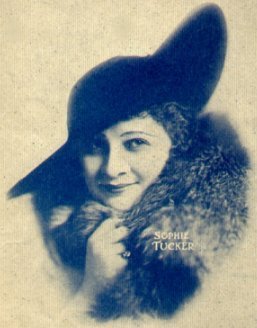 Sophie Tucker, the "Last of the Red
Sophie Tucker, the "Last of the Red Hot Mamas," in furs. She famously
observed, "I've been rich and I've been
poor. Believe me, honey, rich is better."
 Bessie Smith, "Empress of the Blues."
Bessie Smith, "Empress of the Blues."Carl Van Vechten
 The incomparable Mae West. "It's not
The incomparable Mae West. "It's not the men in your life that counts, but the
life in your men."
Allan warren
The gay contingent have always worshiped Woman, even though (or because?) they don't sleep with her. But not just any woman; they flock to older women of great accomplishment, usually in the performing arts. (They have little interest in the Maiden, whom the Hero of legend wins by performing acts of great courage.) I have never been a part of this scene, not having the stuff of a courtier, but many of my friends have participated. These goddesses are too familiar to name. Nothing new here; Sarah Bernhardt drew to her salon in Paris a circle of gay writers, forgotten today but well known in their time. What motivates these worshipers? Recognition of true talent? The need of yet another mother? Identification? A little of all these? I've consulted several friends, but they have no explanation beyond the obvious recognition of talent. In the case of one performer, it probably involves identification with her vulnerability. But the others always seemed marvelously on top of things. So what explains it? I'm open to suggestions.
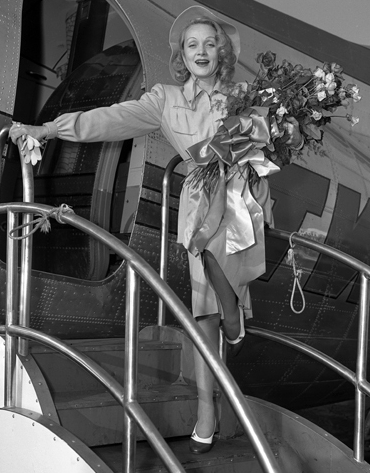


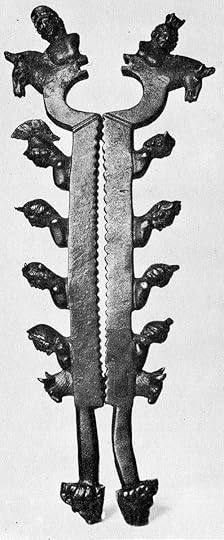 A bronze castration clamp,
A bronze castration clamp,used in the cult of Cybele. Worship of the Goddess could be risky. One of many religions flourishing in ancient Rome before the triumph of Christianity was the Phrygian cult of the Magna Mater or Great Mother, also called Cybele, the mother of gods and men and the source of all life, who was especially identified with wild nature. She had loved the shepherd Attis who, to punish himself for infidelity, castrated himself and died. Mourned, resuscitated, and then deified by her, Attis was worshiped along with the Goddess. Their annual spring festival lasted several days; on March 24, the Day of Blood, neophytes danced wildly to the sound of flutes, drums, pipes, cymbals, and tambourines, then cut themselves with knives, and at the height of their frenzy, when insensitive to pain, castrated themselves and flung their severed members onto the lap of the Goddess's statue, thus achieving union with both her and Attis. It is even possible that some men, mere bystanders witnessing the dance, became so caught up in it that they too emasculated themselves, which must have made for sobering reflection afterward. Contemporary writers mention the "mincing" walk of the Galli, or eunuchs, and even after the coming of Christianity Saint Augustine tells of Galli "parading through the squares and streets of Carthage, with oiled hair and powdered faces, languid limbs and feminine gait, demanding from the tradespeople the means of continuing to live in disgrace." There is little doubt as to who these devotees were, which invites further reflection on the gay worship of Big Mama. How much of a sacrifice does she demand, and why? Books could be written ... and maybe have been.
 The Archigallus, or head priest of the Galli,
The Archigallus, or head priest of the Galli, sacrificing to Cybele. But the offering isn't
what you think. As a Roman citizen, he
himself was barred from emasculation.
Lalupa
Note on "mincing": This is obviously a code word for "gay" and "femme," but I have yet to see anyone, gay or otherwise, walk with a "mincing" step. Am I missing something or is this fiction pure and simple?
So we have come at last to the dark side of the Goddess. Kali is the Hindu goddess of time and change, often presented as dark and violent and associated with death and destruction, though she is also worshiped as a benevolent mother goddess. She is described as having four arms and being black in color (black symbolizing the infinite), her hair sometimes disheveled, her eyes red with rage, her tongue protruding from her mouth. In the middle of her forehead is a third eye that represents wisdom. Her two right hands make gestures of fearlessness and blessing, but her two left hands hold a sword and a severed human head. Often she is shown naked, or wearing a skirt made of human arms and a garland of human heads. Not someone you would care to encounter, or even imagine, on a dark night, though that is exactly when she is worshiped in Bengal. The Thugs, professional assassins who once roamed the highways of India, killing travelers and stealing their valuables, belonged to a cult that worshiped her and asked for her blessing before setting out on a murderous expedition. A rather complex lady, as you can see, having many aspects, some of them quite contradictory and some of them just plain nasty.
 The Kali idol at Dakshineshwar.
The Kali idol at Dakshineshwar. Jagadhatri
 Luidger
LuidgerRivaling Kali in the dark and sinister is Coatlicue, the Aztec goddess who gave birth to the moon and stars, and to the god of the sun and war. She was also known as a goddess of the earth, a goddess of fire and fertility, and of life, death, and rebirth. "Coatlicue" in Nahuatl, the language of the Aztecs, means "the one with the skirt of serpents," and she was represented as a woman wearing a skirt of writhing serpents and a necklace of human hands, hearts, and skulls, her face formed by two serpents meeting head to head. She was the devouring mother, the insatiable monster containing both womb and grave, the force consuming everything that lives. I have seen this famous statue of her in the National Museum of Anthropology and History in Mexico City, and believe me, it's a sight you won't easily forget.
Kali and Coatlicue, life and death inseparable in each of them, the goddess turned monster, wise but ruthless, a terrifying force to be placated, to be worshiped. Ignore her at your peril.
India and pre-Columbian Mexico? Again, you may ask, what's the connection with New York? Except for the Virgin in Catholic churches, the cult of the Mother Goddess isn't exactly widespread in the city. Admittedly it's a bit of a stretch, but representations of Big Mama are here all over the place. In the Met, for instance:
[image error] InSapphoWeTrust
 Yair Haklai
Yair Haklai Random Variables
Random VariablesAnd at the Museum of Modern Art:


You will never get clear of her, nor should you.
Women too worship the Goddess. How could they not when, being one with them, she bestows fertility and imparts secrets of healing? But most societies are male-dominated, and that does much to shape her image and role. What, then, is this all about? It's about how men regard women. Ever since male-dominated societies replaced that much earlier society of the time when God was a woman, men have admired, glorified, and revered Woman, possessed her, been baffled by her, loathed her, dreaded her. What they cannot do is ignore her. She is the mysterious Other, a vital force, the source of human life. So it has been and always will be, as long as there are humans on this earth. Today's feminism simply adds spice to the drama.
As for the Goddess's contradictions, consider the Coptic manuscript of a Gnostic poem from the 2nd or 3rd century CE, discovered with other Gnostic texts in a sealed earthenware jar in Upper Egypt in 1945. Probably these texts were a library hidden by Christian monks from a nearby monastery, when such works were banned as heretical. The poem is a long monolog by a female divinity addressing her worshipers or potential converts; an excerpt follows.
For I am the first and the last.
I am the honored one and the scorned one.
I am the whore and the holy one.
I am the wife and the virgin.
I am the mother and the daughter.
I am the barren one and many are her sons....
For I am knowledge and ignorance.
I am shame and boldness.
I am shameless; I am ashamed.
I am strength and I am fear.
I am war and peace.
Give heed to me....
But I, I am compassionate and I am cruel
Be on your guard!
There speaks Kali/Madonna/Cybele/the Whore of Babylon/Aphrodite/Eve. Forbidden knowledge. No wonder the monks had to hide her in a sealed jar buried deep.
Note on Union Square: On the morning of May 1 I happened to find myself in Union Square again, chiefly to visit the greenmarket, which I reported on in an earlier post (#17, July 2012). The first thing I saw: police barricades along the curb -- a reminder that this was indeed May 1 and demonstrations were anticipated. The second thing: a pianist sitting at an upright piano and pounding away on the keys. The third thing: an anarchist stand with loads of free pamphlets; I helped myself to three: "Anarchist Basics," "Profiles of Provocateurs," and Noam Chomsky's "Notes on Anarchism." The fourth thing: a black woman in a turbanlike headdress and bright red jacket, sitting cross-legged on a purple cloth, evidently selling fabrics and small packets, perhaps of exotic scents; she was straight out of The Arabian Nights or a Hindu legend. Then, finally, I got to the greenmarket and its stands selling honey, hard cider, wheatgrass, horseradish jelly and fig jam, apples, potted herbs, and acres of flowers. Also on hand were the Garden of Spices poultry farm, and Roaming Acres Farm with pure Berkshire pork and ostrich jerky (no nitrates). Later, as I was leaving the market, a seven-man band came marching, blasting away a kind of music that wasn't quite ragtime and wasn't quite jazz: a rousing finale to my visit. And quite a visit it was, though what I saw was only the appetizer anticipating the feast to follow, the afternoon May Day demonstrations. Where but in New York?
Banknote: JPMorgan Caught in Swirl of Regulatory Woes: such was a boldface caption on page 1 of the New York Times of Friday, May 3. Which strikes me as a rather cheap shot by both the Times and the federal government. Talk about hitting a man when he's down! The authorities are just piling one charge on top of another, as if to lay low once and for all a noble institution that dates back to the age of old J.P. himself, that most august of bankers and a real American. Jamie Dimon, the CEO, says he's sorry. Isn't that enough? Has the government no compassion? Shame on it and on the Times. When I go to my branch of that fine institution, I'm greeted with the most cordial hellos. The Easter Bunny and the balloons are gone, but there is candy everywhere; when I made my modest deposit, the teller thrust a chocolate goodie at me with the warmest smile. Clearly, this is not an evil institution. The government should leave it alone -- it and all the other fine banks that strive so tirelessly to serve us all. Libertarians, unite! If our meddling government must investigate someone, let it investigate Occupy Wall Street and the May Day demonstrators, or street food vendors, or sidewalk artists, or other suspect individuals. But leave our banks alone! In the words of Alexander Pope, "To err is human; to forgive, divine." Why can't our government be a little bit divine?
Next week: Is America Becoming a Fascist State? (WBAI-inspired, with arguments for and against). Then, in whatever order: The Saga of Jim Fisk (in several posts), Farewells (coffins, kiss-offs, a mother's rage), and the Magnificence and Insolence of Trees. And maybe: Who is a hero?
(c) 2013 Clifford Browder
Published on May 05, 2013 05:16
April 28, 2013
58. Steamboat Wars on the Hudson
Capitalism loves competition. America loves competition. Think of Apple vs. Samsung today, or AT&T vs. Verizon, or Coca-Cola vs. Pepsi-Cola, or years ago, Macy's vs. Gimbels (as seen in the old holiday-season movie Miracle on Thirty-fourth Street), or any number of other corporations. Competition is in our blood and bone. And for sure, it's in the blood and bone of New York. But competition today is tame and genteel, compared to the nineteenth-century steamboat competition on the Hudson.
June 13, 1840: As the steamboat Napoleon, 179 tons, a small, ill-furnished vessel skippered by Joseph D. Hancox, a feisty captain who had challenged the prevailing Hudson River Steamboat Association, pulled away from its North River dock with a load of passengers and headed up the river toward Albany, the much larger De Witt Clinton, 500 tons, broke away from its berth and, with full steam up, headed straight for the other boat. As a crowd, dawn there by rumors of a confrontation, watched from the waterfront, Hancox signaled the De Witt Clinton frantically and, when it still bore down, whipped out a revolver and fired three shots at the other boat's pilothouse, hitting no one but forcing the pilot to duck. Moments later the larger boat rammed the Napoleon just aft of the pilothouse, causing it to careen violently amid the screams of its terrified passengers. Miraculously, the boat then righted itself and continued on its way. Had the De Witt Clinton struck its rival square amidships, as it had evidently intended, the Napoleon would surely have sunk. Yet when the Napoleon reached Albany and word of the incident spread, it was not the attacking vessel's captain who was arrested, but Hancox, charged with felonious assault with his revolver. Pleading self-defense in the shooting, and backed up by dozens of his passengers as witnesses, Hancox was readily acquitted, after which he slashed his fare to fifty cents and continued to challenge the Association.
Standing on the forward deck of the De Witt Clinton during this incident was veteran steamboat operator Isaac Newton, a member of the Association, who was presumably on hand to oversee the operation. This was a time of cutthroat competition on the river, when the approved methods of eliminating a rival were to buy it off or, failing that, to steal its berth and passengers, to race it, to crowd it, or to smash it. Since Hancox was that rare phenomenon, a rival captain who couldn't be bought off, Newton had decided to ram his boat and disable it. Fortunately for his legacy, he was also a gifted ship designer who soon teamed up with Daniel Drew, the cattle drover turned tavernkeep turned steamboat operator (see post #54), to found the People's Line and operate boats on the lucrative New York-Albany run, Newton designing their ships while Drew handled the finances.
If Newton's reputation didn't suffer much from this incident, it's because keen rivalry and all that resulted from it were the rule on the Hudson. All up and down the river runners selling tickets solicited travelers boisterously on the piers, praising their line's boats while decrying those of any rival line, whose boilers, they liked to tell nervous ladies, were anything but safe. Yet when a steamboat approached any intermediate landing, no passenger dared assume there would be even momentary contact between the vessel and the landing, or even between the boat and himself. If the boat was racing it would probably shoot right past the landing, or failing that, it would execute a "landing on the fly," lowering a small boat that, joined to it by a rope, was propelled by the vessel's momentum to the dock, where it hastily discharged passengers and their baggage and took on more of the same, and then was drawn back to the vessel by a windlass on the vessel's deck, the vessel having lost little time in the process. Such landings were even performed at night, with considerable risk to the passengers.
 Vanderbilt again, but not yet
Vanderbilt again, but not yet "Commodore."
Steamboat skippers and owners relished the prevailing competition, each being determined to prove that his boat was the best and fastest on the river. Memorable was the contest of June 1, 1847, when Cornelius Vanderbilt pitted his luxurious new C. Vanderbilt, named modestly for himself, against the speedy Oregon of his pugnacious rival George Law, a coarse-featured canal construction contractor turned banker and railroad man who was branching out into steamboats as well. During the race on the Hudson, Vanderbilt in his excitement seized the wheel from the pilot and mismaneuvered his vessel, while Law, out of fuel, hurled furniture and costly fittings into the furnaces and so sailed on to win.
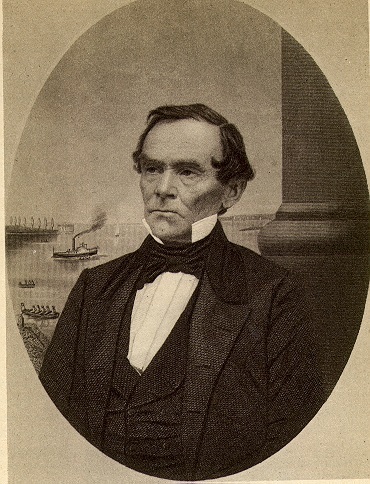 Daniel Drew in his steamboating days.
Daniel Drew in his steamboating days.No whiskers yet, and not yet "Uncle Daniel."
Such passion was beyond Daniel Drew, an astute money manager who lacked the gut feeling of a river man, the skipper's fervent identification with his boat, his confidence that it was the best damn boat on the river and he'd race anyone fool enough to doubt it. One can't imagine Drew planting himself on the forward deck of a boat just prior to a planned collision. As for hurling sofas into a furnace during a race, why good heavens, those things cost money!
Drew and Newton knew there were defter ways to compete. Country boys who had evolved by way of the freight barge and the cattle yards, they grasped early that the key to success on the Hudson was luxury. Rivaling their countrymen's lust for speed was their longing for regal elegance: the craving of egalitarian, homespun America for palatial opulence such as few citizens could afford in their private lives, but they could enjoy briefly for the price of a steamboat ticket. The result was a trio of floating palaces such as the world had never seen, to construct which they marshaled the skills and resources of the East River and Brooklyn shipyards for the hulls, the great ironworks of the city for the engines, and the massed talents of the carpenters, plumbers, painters, gas fitters, upholsterers, furniture and glass makers, and privisioners -- not to mention the journalists -- of New York.
The first of these marvels was the mammoth Hendrik Hudson, which went into service in October 1845: a night boat with berths for 620 people and other accommodations for, it was claimed, two thousand -- admittedly a rather fanciful number. A reporter, surveying its illuminated interior with spacious saloons flanked by cabins, likened it to Cleopatra's royal yacht at night. But exactly one year later the second marvel appeared: the Isaac Newton, with the biggest engine ever built in America, a main saloon with a stained-glass dome overhead, and luxurious staterooms, the fanciest being the Bridal Room, with carpeting said to be from the drawing room of King Louis-Philippe of France, and over the bed a painted altarpiece featuring a cupid holding two doves over an altar, which a spellbound journalist hailed as "one of the most splendid achievements of taste."
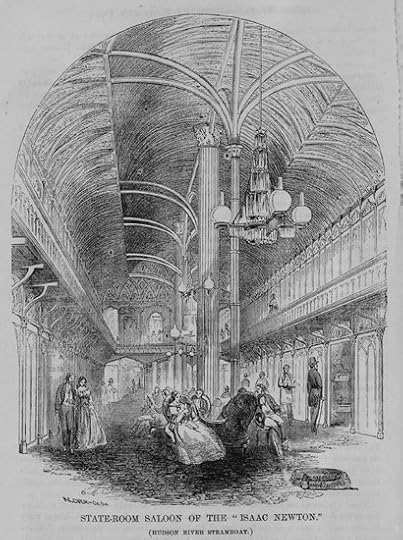 The stateroom saloon of the Isaac Newton.
The stateroom saloon of the Isaac Newton.Unsurpassed luxury, until the next boat
surpassed it. Could such marvels be surpassed? In the age of Go Ahead, if one had eclipsed all others, what remained but to eclipse oneself? In June 1849 the day boat New World appeared, the longest and largest river steamboat ever built, with furnishings that included satin damask chairs, marble tables from Italy, Corinthian pillars, and real oil paintings on the walls. On its first trip up the river it was saluted on land and water the full length of its run, and greeted in Albany by twenty thousand people thronging boats and wharves, who waved handkerchiefs and cheered while bells tolled and cannon boomed. Thereafter the paying public flocked aboard the New World and the other People's Line vessels hundreds at a time, until on September 4, 1850, when a state fair was luring unprecedented multitudes to Albany, the New World on a single trip broke all records by carrying an astonishing twelve hundred passengers. Thanks to the managers' grandiose vision, the profits of the People's Line soared.
It would be comforting to report that rivalry through luxury put an end to cutthroat competition on the river, with its attendant risks, but such was not the case. On July 28, 1852, the steamboat Henry Clay, with many prominent citizens aboard, left Albany for New York. Also bound for New York was the rival boat Armenia, and a race ensued between the two, with many gentlemen in the Henry Clay's bar betting on the outcome. When the Armenia pulled ahead, the Henry Clay cut in front of it so as to beat it to the next port, causing a collision that alarmed the passengers but did no damage. At Poughkeepsie several nervous passengers left the vessel, despite assurances by the crew that there was absolutely no danger. The race continued, with boiler heated to the limit and then some, until embers from the Henry Clay's smokestacks showered down on the wooden deck, which immediately caught fire. Crewmen pushed the passengers back toward the stern, and the boat was run aground at Riverdale in the Bronx, with its stern over deep water; it burned to the water's edge. Panicky passengers trapped on the stern jumped overboard and many drowned. The final toll was 81 dead -- the worst steamboat disaster ever on the river. Passengers who had left the boat at Poughkeepsie and took a train from there to New York witnessed the disaster en route and realized that this would have been their fate, had they remained on the Henry Clay. A great public outcry followed, causing Congress to pass the Steamboat Inspection Act of 1852, providing for more rigorous inspection of boilers and the licensing of all passenger-steamboat engineers and pilots. (All advocates of government regulations can give forth a hearty cheer.)
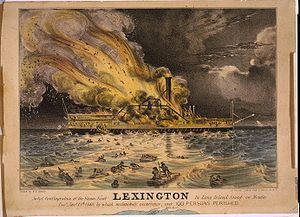 A Currier & Ives print of the burning of the steamboat Lexington on Long Island Sound in 1840.
A Currier & Ives print of the burning of the steamboat Lexington on Long Island Sound in 1840.Currier & Ives, when not presenting the heart-warming family scenes and idyllic pastoral landscapes that would adorn the walls of countless American homesteads, also took delight in presenting rail and steamboat disasters. The loss of the Henry Clay was so commemorated, as was the burning of the Lexington with even greater loss of life. But that didn't stop people from traveling by rail or boat, any more than news of airplane disasters stops us from doing the same.
 The Daniel Drew, a day boat mentioned
The Daniel Drew, a day boat mentionedhere, should not be confused with the
Drew, the night boat shown below.
Uncle Daniel had only two boats named
for him; Vanderbilt had too many to count.
By the 1860s cutthroat competition had all but vanished from the Hudson, where Drew's People's Line dominated the night boat traffic to Albany, while leaving the day business to the Hudson River Day Line. So all was sweetness and light on the Hudson ... almost. The "almost" refers to Captain J.D. Hancox, the feisty skipper of the Napoleon, who popped up again in 1874 as owner of the eleven-year-old J.B. Schuyler, with his son Clement as skipper. The Hancoxes couldn't compete with the big boats of the day in speed, but they had a host of other tricks up their collective sleeve. One rainy night the Schuyler docked at Albany above Daniel Drew's sumptuous Dean Richmond, which was awaiting the arrival of a train with passengers hoping to continue their trip by boat. Clem Hancox went ashore and, when the train came chugging along, waved a red lantern signaling danger. The train stopped, and while its crew were investigating, the passengers got off, thinking they had arrived at the station, and flocked aboard the Schuyler, which quickly departed before they could realize their error. When the train finally reached Albany, there were no passengers aboard for the Dean Richmond.
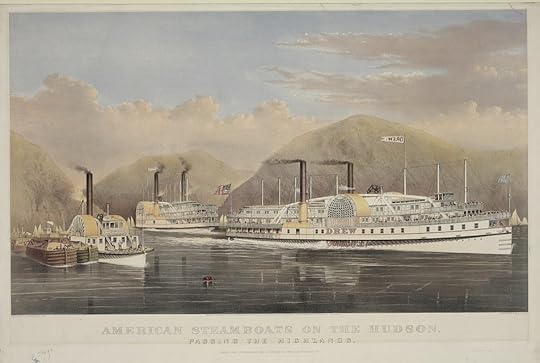 A Currier & Ives print. Conspicuous in the foreground is the Drew, one of the
A Currier & Ives print. Conspicuous in the foreground is the Drew, one of thePeople's Line vessels that Hancox liked to harass.
But the Hancoxes had other tricks as well. The Schuyler, with a band aboard, would pull up alongside a rival boat and strike up its band. Passengers on the other boat would flock en masse to one side so as to better enjoy the music, causing the boat to list with one paddle out of the water; then, as the rival boat lost speed, the Schuyler would race ahead and get to the next landing first. The captain of the Dean Richmond finally found a solution: when the Schuyler came alongside with its band at full blast, he ordered the safety valves of his boat to be lifted, creating a screeching noise that drowned out the band. The People's Line boats then installed bands of their own, but in July 1875 it got rid of the gadfly at last with the time-honored solution of buying him off. Hancox then ran his vessel for years as an excursion boat, and peace and serenity settled down on the Hudson definitively. Things were calmer but just a bit boring.
Daniel Drew, Isaac Newton, George Law, J.W. Hancox, and the redoubtable Vanderbilt: such were the colorful figures operating boats on the Hudson. Only Vanderbilt is remembered today, and mostly for his railroads, but these practitioners of Go Ahead were all recognized and honored in their time. When Isaac Newton died in 1858, on the day of his funeral flags flew at half mast in New York harbor, and in Albany ships' bells tolled, and artillery on Steamboat Square fired salutes for an hour. And when Vanderbilt sailed off to Europe in 1853 in the steam yacht North Star, the biggest and most luxurious private yacht in the world, and one built in part according to his own design, he created a sensation on both sides of the ocean by this unprecedented tour of the Old World by a self-made man of the New. He was feted by capitalists in Paris and given the use of one of the Czar's carriages in St. Petersburg, while in London the Daily News likened him to the Medicis and declared that the word parvenu should be looked upon as a word of honor. He was a sterling example of the New Man, the distinctive American type, self-made, industrious, and versatile, who was beginning to fascinate Europe. Henry James in his novels would show this type of American interacting with refined (and decadent?) Europeans, and with American expatriates more at home in Europe than America.
 Vanderbilt's North Star, a luxury yacht that, like its owner, fascinated all of Europe.
Vanderbilt's North Star, a luxury yacht that, like its owner, fascinated all of Europe.It was a propos of Vanderbilt that the term "robber baron" was first used, and by the end of the nineteenth century these artists of Go Ahead were reaping blame as well as praise. What do we think of them today? What is your opinion, for instance, of Steve Jobs of Apple, Bill Gates of Microsoft, and Mark Zuckerberg of Facebook? Not to mention the CEOs of banks? Do they merit praise for their innovative energy and know-how, or blame for ruthlessness and sharp business practices? Is the New American still with us, and is he (so far, usually a "he") a hero or a villain? Or a hero and a villain? In my opinion, a debate worth having.
 Does he deserve to be set on a pedestal?
Does he deserve to be set on a pedestal? mylerdude
mylerdudeAnd do they... ?

 Silverisdead
SilverisdeadNote on income taxes: Like me, most of you have probably just coughed up money for your federal (and maybe state) income tax. But not everybody has to. Did you know that thirty U.S. corporations quite legally paid no federal income tax -- yes, I said none, and I mean none whatsoever -- in 2008, 2009, and 2010? Among them are such familiar names as General Electric, DuPont, Verizon, Boeing, Consolidated Edison, Wells Fargo, and Honeywell. Which is worth pondering. As for me, I'm just a mite angry. Why is this legal? Does Congress represent the voters, or does it represent corporations? No wonder Occupy Wall Street -- among others -- is up in verbal arms. But conspicuous by their absence from the Lucky Thirty are two companies for which I have a special regard:
The company I love to love: Apple. Yes, I know it has its faults, but sometimes one loves anyway, and besides, I have a Mac.
The company I love to hate: Monsanto. If you don't know why, I can't do a tutorial here, nor am I particularly equipped to do so. But if you poke around, you'll find out plenty. For a start, think GMOs, think patents, think seeds. This involves you more than you may realize.
Next week: Earth Goddesses: Big Mama, mentioning (among others) Eve, the Virgin, Aphrodite, the Whore of Babylon, Kali, Coatlicue, a castration clamp, and the Last of the Red Hot Mamas. Forthcoming: Farewells and the Saga of Jim Fisk. Also in the works: Is America Becoming a Fascist State? (WBAI again). Hope you've all paid your income tax, unless -- like the Lucky Thirty -- you don't have to.
(c) 2013 Clifford Browder
Published on April 28, 2013 05:22
April 21, 2013
57. Gardens
This is about gardens, both mythic and real. But I am not a gardener and never have been, so don't expect tips on gardening.
At the tender age of four or five I and Patty Taft, a neighbor, took a walk together and, seeing Mrs. Pierce's garden ablaze with tulips of every shade and hue -- a garden that was the talk and envy of the neighborhood -- we entered it and picked a few tulips to take home and give to our mothers. Shocked, my mother sent me at once to apologize to Mrs. Pierce, and on the way I heard Patty's screams as her mother spanked her vigorously. Fortunately, Mrs. Pierce was amiable and forgiving, but there, right from the start, was the pattern: forbidden garden, temptation, violation, punishment.
 A 15th-century manuscript illustrating the Roman
A 15th-century manuscript illustrating the Roman de la Rose. Here, the blue-clad lover gains entry to
the walled garden and encounters allegorical figures
as he tries to find the rose.
Many years later I would find a similar pattern in the opening section of the Roman de la Rose (Romance of the Rose), a famous medieval French allegory of courtly love. In the poem a lover gains access to a walled garden where he encounters a rosebud, is smitten with love for it, and finally kisses it, but then is driven away by hostile forces that erect even greater barriers around the rose bush. Patience will be necessary, and a long preparation, before he can hope to pluck the rose.
Gardens -- especially secret or forbidden ones -- have always fascinated me. The first poem I ever wrote was about a secret garden, a bit of juvenilia that I soon had the good sense to obliterate. Some years later I started writing sonnets, one of which also described a garden and ended with the line "The lupine bloomed, voluptuous and obscene." Which, for my taste today, is a bit too direct, too obvious. But I was still a virgin then, so what can you expect? This poem too has happily been consigned to oblivion.
In that second poem the garden was certainly sensual, which brings to mind the Bower of Bliss in the second book of Spenser's rich but interminable romance, The Faerie Queene. In that book Sir Guyon, a knight representing Temperance, sets out on a quest to put an end to the witch Acrasia's sensual garden, where, like the sorceress Circe in the Odyssey, she seduces men and turns them -- literally -- into beasts. After many adventures and misadventures Guyon arrives at the Bower, a "daintie Paradise" with trembling groves and "crystall running by," shady dales, "painted flowres," joyous birds, soft music, a plashing fountain, and gentle winds -- in short, everything in nature conducive to seduction and love. He surprises her lying with a lover on a bed of roses (no thorns, I assume), makes her a prisoner, and tears the Bower to pieces. When I read this in college -- yes, I read the whole darn Faerie Queene, all six books, one of the longest poems ever written -- I confess that I found Acrasia far more interesting than Sir Guyon, and much regretted the destruction of her Bower.
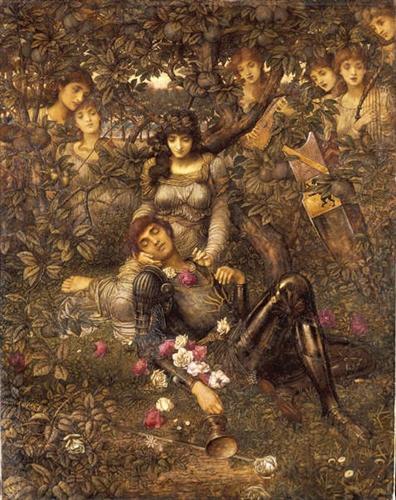 John Melhuish Strudwick, Acrasia, ca. 1888.
John Melhuish Strudwick, Acrasia, ca. 1888. Strudwick was a Pre-Raphaelite painter and like many Victorian artists found inspiration in The Faerie Queene. Here he shows Acrasia and her handmaidens with a captive knight. But to my eye this Victorian work looks innocent, with not a hint of bare flesh. But in Spenser's poem things are different:
Upon a bed of Roses she was layd,
As faint through heat, or dight to pleasant sin;
And was arayd, or rather disarayd,
All in a vele of silke and silver thin,
That hid no whit her alabaster skin,
But rather shewd more white, if more might bee...
Her snowy brest was bare to ready spoyle
Of hungry eies, which n'ote therewith be fild...
(FQ II. xii. lxxvii-lxxviii)
The Victorian age is not known today for great painting, but I'm always curious to see how the artists back then coped with sensuality. In Strudwick's painting, by keeping all concerned well clothed.
[image error] Martin Schongauer, Madonna in a Rose
Garden (ca. 1473). Virginity and purity,
contrasting with Acrasia's bed of roses.
Acrasia's opposite is, of course, the Virgin Mary, whom medieval and Renaissance painters often showed in a locked garden, symbolic of her virginity. The image comes, ironically, from the exuberantly sensuous, if not sensual, Song of Solomon 4:12: "A garden locked is my sister, my bride, a garden locked, a fountain sealed." To deal with this passionate love song, which some have even found erotic, Christian commentators have traditionally interpreted it as expressing the love of Christ and his bride, the Church. My only comment: boy, that is some love!
Getting into Greek mythology, I was fascinated by another forbidden garden, the Garden of the Hesperides, situated vaguely in the far west of the known ancient world, where the goddess Hera set three nymphs, the Hesperides, to guard the golden apples that she had received as a wedding gift from Gaia, the earth goddess, when she accepted Zeus -- apples that, if eaten, conferred immortality. Not altogether trusting the Hesperides, Hera posted an additional guardian, the never-sleeping hundred-headed dragon Ladon. Guardians enough, one would think, but the apples were stolen twice. Eris, the goddess of discord, made away with one, inscribed it "For the fairest," and rolled it into a wedding party to which she had not been invited, causing Hera, Athena, and Aphrodite to claim it -- a dispute that provoked the Trojan War. And Heracles, for his eleventh labor, managed to steal some of the apples by trickery.
 Frederick Leighton, The Garden of the Hesperides, ca. 1892.
Frederick Leighton, The Garden of the Hesperides, ca. 1892.In this late Victorian work the Hesperides are seen dozing on the job. No wonder Hera added a dragon (here, a one-headed snake) as an extra guard. But the nymphs seem quite cozy with it. For me, in contrast with Strudwick's Acrasia mentioned earlier, everything about this painting -- the dozing damsels, the phallic snake, the clustered golden apples -- seems subtly erotic. Ah, those sly Victorians! Leighton, an English sculptor and painter, was the first artist to be made a peer. He died one day later
-- the shortest peerage in history.
Of course the supreme forbidden garden of Western lore is Eden, which itself was not forbidden, but whose Tree of Knowledge and Tree of Life were not to be touched by Adam and Eve. The former gave knowledge of good and evil, while the Tree of Life conferred immortality, and Yahweh didn't want them to mess with either. The plants in the garden are not specified by the Book of Genesis, which mentions only "every tree that is pleasant to the sight, and good for food" (2:9). The most famous description of Eden in English literature is surely Milton's, in Book IV of Paradise Lost, where "Cedar, and Pine, and Firr, and branching Palm" are mentioned, along with "goodliest Trees loaden with fairest Fruit," and trees weeping odorous gums and balm, and golden fruit "Hesperian fables true," and "Flours of all hue, and without Thorn the Rose," and the vine that "layes forth her purple Grape."
Granted, this lacks the sensuous immediacy of Keats and Tennyson. (Yes, Tennyson! I said "sensuous," not "sensual.") But Milton was far more scholar than nature lover, and blind as well.
Eden captured the Western imagination as an earthly paradise, a place of peace and innocence where the lion could lie down with the lamb, an exotic setting where unicorns stalked groves of fruit-bearing trees. For me, Eden lies in the realm of myth, but scholars have tried to fix its location -- usually somewhere in the Middle East -- and the Mormons, following the revelations of Joseph Smith, are convinced that it was situated in present-day Jackson County, Missouri. But then, why not in upstate New York, which produces an abundance of apples? Maybe near Rochester, or in the vicinity of Schenectady. Upstate could use the tourist business that would certainly accrue.

God with Adam and Eve in the Garden of Eden, a painting by the sixteenth-century artist Jacob de Backer. To the left we see God creating Eve out of Adam's rib while he sleeps.
 In this Raffael mural in the Vatican the tempter
In this Raffael mural in the Vatican the tempteris Lilith, a serpent-like female demon --
presumably a stand-in for Satan.
You know the story: tempted by Satan in the form of a serpent, Eve gives the apple of the Tree of Knowledge to Adam, who then eats it. This leads to their expulsion from the garden and all our woes, a subject that artists have loved to render over the centuries.
Note on the serpent: I have always felt that snakes quite undeservedly have a bad press, and the serpent's role in Eden certainly doesn't help. Most snakes encountered in this area (New York, not Eden) are harmless, and the one exception I know of -- copperheads on the Palisades (see post #49) -- take care to avoid humans. To my eye snakes are beautiful, mysterious, and sensual, and we could well see them as phallic in both Eden and the Garden of the Hesperides. But our globe-trotting doctor, who has a house in Capetown, South Africa, assures me that snakes -- certain snakes -- deserve their reputation. His garden there is frequently invaded by cobras and vipers; only the presence of two mongooses keeps these intruders at bay.
 The expulsion from Eden, as shown in a bas-relief
The expulsion from Eden, as shown in a bas-relief on the façade of the cathedral of Orvieto.
JoJan
What common theme runs through the accounts of all these gardens? The garden shields an object of great value that the hero or intruder covets, an object whose possession confers something of immense significance -- love, knowledge, immortality -- but that can be obtained only with tremendous effort or at great risk. It's all about our longing for something difficult of access that, once possessed, may bring unimaginable happiness or deep misfortune. Which is plenty to chew on.
Let's turn now from the gardens of myth and legend to the very real gardens that I have visited here in this city. A bit of a comedown, you may think. But what if I told you that right here in the West Village, only a few short blocks from where I live, there is a walled garden sometimes open to the public and sometimes not, with pomegranate and fig and Cedar of Lebanon close by, as well as other rare exotics, and smack in the middle, a noble tree bearing a rich harvest of apples. You would be a little bit surprised, would you not? But it exists. Yes, a rich harvest of apples. Alas, crab apples. In the autumn those runty little yellow things litter the ground, quite inedible for humans and therefore of interest only to insects and worms. No one would confront a dragon or risk the wrath of Yahweh for crab apples.
The garden with the crab apple tree is the Barrow Street Garden of Saint Luke in the Fields, a landmark church on Hudson Street that dates from 1821. I wouldn't demean its garden for anything, since I have spent restful moments in the shade of that very tree, while others around me rested or read quietly or reflected. Magnolias bloom there, as well as witch hazel, irises, roses, rhododendrons, and several plants from Japan and other parts of Asia. Near it is the church's Biblical Garden, comprising plants mentioned in the Bible, Cedar of Lebanon among them, and a Rectory Garden rarely open to the public, with a rare Chestnut rose from China, and a papaw tree that bears exotic banana-flavored fruit. Because of the gardens' southwest orientation and their heat-retaining brick walls, Saint Luke has managed to grow several species rarely seen this far north, like pomegranate, rosemary, and fig. No apples conferring immortality here, and no unicorns, but marvels enough.
Note on the above: I just revisited Saint Luke's gardens and have noticed changes. Entering the Barrow Street Garden, I immediately encountered an ornamental iron basin crammed with pansies in riotous bloom. There were other spring flowers too, but in the center of the garden was a slender tree, as yet without leaf or flower, that looks too small, too svelte to be the crab apple tree of yore. But I could be mistaken; time will tell. Their current info mentions several gardens, but no Biblical Garden; has that too been superseded? I hope not. The thought of a Cedar of Lebanon were in the West Village was enticing.
New Yorkers, living in a desert of concrete and asphalt and cement, are starved for gardens and greenery. And, God bless them, they do try. Out on errands just now, I walked along West 11th Street from Bleecker to Seventh Avenue, and in the course of my walk saw daffodils and tulips in window boxes, in pots on the steps of front stoops, in the skimpy areas fronting row houses, and in little rectangular plots near the curb that often have signs posted, pleading with dogs and their owners to forbear. What the back yards and rooftops harbor, I couldn't see.
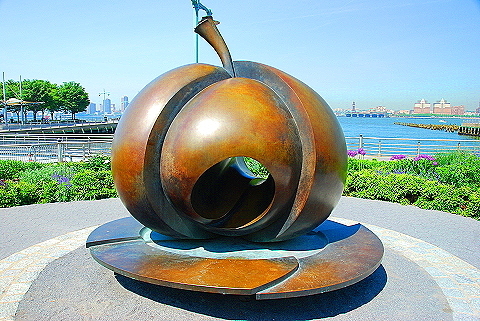 Art Nerd New York
Art Nerd New YorkBut those bits of greenery are hardly gardens, properly speaking. But gardens -- real gardens -- do exist. One that I love to visit is the Millennium Garden in the Hudson River Park at the end of Charles Street, near the river. Dominating it is sculptor Stephan Weiss's work "Big Apple," a modernist bronze rendering of an apple ten feet high. A sign forbids visitors to crawl on it, but, having a kind of tunnel right through it, the sculpture begs to be crawled through, and telling New Yorkers not to do something guarantees that they will do it. Sometimes I have this little garden to myself, but often there are other visitors crawling through the sculpture and having their transgression recorded by camera. I have adopted the garden and make a point of picking up the rare bits of litter that find their way into it. When the summer flowers are thick and exuberant, I love to view them with the nearby river as a backdrop, a view that reminds me of the American Impressionist Childe Hassam's paintings of gardens on the Isles of Shoals, in the Atlantic just off the coast of New Hampshire. For me, masses of thick flowers at the peak of their blooming, seen against a vast expanse of ocean, present a rich excess of life.
 Childe Hassam, Celia Thaxter's Garden, 1890.
Childe Hassam, Celia Thaxter's Garden, 1890.What, by the way, is the difference between a garden and a park? Parks are bigger, gardens are smaller and more intimate. Not always: I've visited some very big gardens, and some very small parks like the pocket parks of Midtown Manhattan. Gardens are private, parks are public. Usually, but some gardens are public, too. Gardens are tended more; they are planted and pruned, watered and cleaned, given more tender loving care. Really? Tell that to the Central Park Conservancy, whose volunteers work in Central Park daily. One probably wouldn't go to a garden to jog or cycle, but beyond that I give it up. A garden is a garden because it has been labeled such, and the same is true for a park.
Speaking of Central Park, the Conservatory Garden at Fifth Avenue and 105th Street, New York's only formal garden, is a garden within a park. It comprises three sections: the North, Central, and South Garden. I have already described it in post #21, but will now visit it again. The North Garden often comes alive in the fall with masses of Korean daisies of every color that overwhelm you, suck you in. In the center of the garden is the Three Dancing Maidens fountain, sculpted by Walter Schott in 1910 or thereabouts and formerly installed in the Samuel Untermyr estate in Yonkers, before being given to the city in 1947. The maidens' clothing clings to their bodies, giving an impression that is frankly and deliciously sensual. Appropriate for a private estate in 1910, perhaps, but probably not for a city park. Today, of course, we are more enlightened about such matters, much more evolved.
 Even in winter, they dance.
Even in winter, they dance.Banyan Tree

The Central Garden has a broad expanse of lawn often used for wedding parties, and near it, as if to guarantee procreation, the skyward spume of an orgasmic geyser-like fountain. Flanking the lawn on either side are crab apple allées providing welcome shade in the intense heat of summer.
Ah, some of you are thinking by now, that Browder turns every garden into something sensual. Well, gardens are usually full of flowers, and flowers are by their very nature sensual, flaunting their organs wantonly. I've often wondered how Victorian ladies would have reacted, had they known that the scented geraniums they adorned their parlors with were, like all flowers, brazenly sexual.
The South Garden is my favorite. Rather than masses of flowers, it offers a great diversity of annuals and perennials, most of which I can't identify: coneflowers, hydrangeas, zebra grass, loosestrife, catmint, lady's mantle, and many others, as well as barberry and magnolia. And smack in the center is the Burnett Fountain and Pool, named for Frances Hodgson Burnett, author of the children's classic, The Secret Garden. (To judge by the title, a book I should have known as a child, but didn't. She was also the author of Little Lord Fauntleroy, but we'll let that one pass.) The statuary fountain by Bessie Potter Vonnoh features a young boy reclining and playing a flute, and a standing girl holding a bowl with sculpted birds that functions as a birdbath where real birds mix with the sculpted ones. They evidently represent the main characters of The Secret Garden, but they could just as easily be Peter Pan and Wendy. If the North Garden statuary is deliciously sensual, the South Garden's is inherently innocent; I love them both. Adjacent to the sculptures is a pond with water lilies and, on the bottom, a small fortune in tossed coins. The spot is wonderfully quiet and restful. So you see, I do acknowledge that gardens can be innocent.
 Ephemeral New York
Ephemeral New YorkWhat other gardens should I mention? The Jefferson Market Garden on the site of the demolished Bastille known as the Women's Prison, where the screams and oaths of inmates shouting down to friends on the street have been replaced by magnolia and cherry trees now in bloom, and a rose garden that will achieve magnificence in June? The four-acre Shakespeare Garden in Central Park, offering flowers mentioned in Shakespeare's poetry and plays? Paley Park, a pocket park squeezed in between tall buildings on East 53rd Street in Midtown Manhattan, with trees and flowers and a twenty-foot-high waterfall spanning its entire back wall? The community gardens that self-styled "green guerrillas" have created on neglected vacant lots, reclaiming urban land to raise vegetables and bring people together to deal with the problems plaguing their neighborhoods? I could go on and on, but there's no way I could cover all these gardens. So I'll settle for one very big garden that I have visited many times, the Brooklyn Botanical Garden, a wedge-shaped 52-acre garden next to Prospect Park.
The Brooklyn Botanical Garden is really a conglomeration of many smaller parks, each with its own attractions. Visiting the Native Flora Garden in spring, I have seen wildflowers that I rarely, if ever, see elsewhere: golden club, thrusting a spike of tiny yellow flowers; red trillium, a lovely but ill-scented, liver-red flower; Dutchman's breeches, whose drooping yellow-tipped white flowers look like upside-down pantaloons; wild bleeding-heart, whose two reddish spurs form a heart from which a drop of blood seems to drip between two flaring wings; and shooting star, with swept-back petals and a pointed beak that suggests a star (or missile?) shooting earthward. I've always been a sucker for wildflowers, their colorful names, their intricate shapes.
 shooting star
shooting star
 red trillium
red trilliumAnother spot of interest is the Cranford Rose Garden, with over five thousand bushes bearing nearly fourteen hundred species of roses. I'll admit that, given such a wealth of roses, they may all begin to look alike, and besides, I'm a wildflower guy, but when I visited the garden, the names of the various species grabbed me. Who could resist Wild at Heart, Moondrops, Casanova, Duchess, Glory Days, Dainty Bess, Flash Fire, Apricot Twist, Don Juan, Hoot Owl, Uncle Joe, and Bo-Peep? Someone's imagination must have been cooking, for there is magic in these names.
 The Cranford Rose Garden. A sundial statue in the foreground.
The Cranford Rose Garden. A sundial statue in the foreground.Stavenn
For a massive impression of spring, nothing surpasses the Cherry Esplanade, a broad green rectangle bordered by two allées of double-flowering cherry trees that erupt into bloom in April, transforming the whole area into dazzling pink. No need to go to Washington to stand six- or ten-deep with other tourists to see cherry trees in bloom, when you can do it here with a lot fewer fellow visitors to contend with.

Of course there's a lot more to mention: the Osborne Garden, an Italian-style formal garden; the Japanese Hill-and-Pond Garden, with a miniaturized landscape featuring trees and shrubs shaped by special pruning techniques; the Fragrance Garden; the Magnolia Plaza; the Herb Garden; Bluebell Wood, best seen in May; and many more. I urge anyone who lives in the New York City area to visit the Botanical Garden soon. The cherry trees in the Japanese Hill-and-Pond Garden are at their peak now, and those in the Cherry Esplanade are late this year but will blossom soon; see the website for up-to-date info on what is in bloom and how to get there. Go early, to avoid crowds. What you'll see is unforgettable.
Quote of the day: "The illegal we do immediately. The unconstitutional takes a little longer." -- Henry Kissinger, in the recent public release of documents by WikiLeaks
 Good-bye to the Iron Lady: No sooner had the word spread of Margaret Thatcher's death, but there arose on both sides of the Atlantic a hullabaloo of denunciation and vituperation. The British media were graced with repeated renditions of "Ding dong, the witch is dead" from The Wizard of Oz, and Parliament was convulsed with praise by her admirers and vehement censure by her foes. Here in New York City, station WBAI devoted a full hour to rebuking and decrying her policies as Prime Minister in the 1980s, including a satirical skit whose words I could barely make out and that I found uninspired. (Progressives usually have less bite in comedy and satire than conservatives.) All of which I find unseemly. As for those who gloat over her wretched last days, when she was afflicted with a series of strokes, memory loss, and dementia, I find that contemptible. Admittedly, she was combative and divisive, and her policies highly controversial. I am no admirer of the Iron Lady, but feel that she and her mourners are entitled to minimal respect until she has been decently buried. After that, let criticisms fly. And if the old girl could come back and witness it, she would probably say, as she did once in a stormy session of Parliament, "I'm enjoying this!" A fighter, she loved a good fight. I don't admire her, but I admire three things about her: her energy, her strength, and her commitment. She makes many a politician -- no, I won't name names -- look opportunistic, wishy-washy, tame. So good-bye to the Iron Lady. She won't be forgotten soon.
Good-bye to the Iron Lady: No sooner had the word spread of Margaret Thatcher's death, but there arose on both sides of the Atlantic a hullabaloo of denunciation and vituperation. The British media were graced with repeated renditions of "Ding dong, the witch is dead" from The Wizard of Oz, and Parliament was convulsed with praise by her admirers and vehement censure by her foes. Here in New York City, station WBAI devoted a full hour to rebuking and decrying her policies as Prime Minister in the 1980s, including a satirical skit whose words I could barely make out and that I found uninspired. (Progressives usually have less bite in comedy and satire than conservatives.) All of which I find unseemly. As for those who gloat over her wretched last days, when she was afflicted with a series of strokes, memory loss, and dementia, I find that contemptible. Admittedly, she was combative and divisive, and her policies highly controversial. I am no admirer of the Iron Lady, but feel that she and her mourners are entitled to minimal respect until she has been decently buried. After that, let criticisms fly. And if the old girl could come back and witness it, she would probably say, as she did once in a stormy session of Parliament, "I'm enjoying this!" A fighter, she loved a good fight. I don't admire her, but I admire three things about her: her energy, her strength, and her commitment. She makes many a politician -- no, I won't name names -- look opportunistic, wishy-washy, tame. So good-bye to the Iron Lady. She won't be forgotten soon.Banknote: My ongoing love affair with my bank, J.P. Morgan Chase, continues unabated. When I visited my branch yesterday I found the Easter Bunny gone but, in its place, Munchkins. No, I don't mean those little guys from The Wizard of Oz. I mean those concoctions -- "Little Pops of Pleasure" -- that Dunkin' Donuts puts out. Greater love for its customers hath no bank, even one that lost six billion -- dollars, not Munchkins -- in a trade.
Next week: Steamboat Wars on the Hudson. Forthcoming: Earth Goddesses, Farewells. In preparation: The Saga of Jim Fisk, the most colorful of the nineteenth-century robber barons. Meanwhile I wish all a joyous spring.
(c) 2013 Clifford Browder
Published on April 21, 2013 04:45
April 14, 2013
56. Monumental New York, part 2
When you think of New York, you think of Manhattan and tall buildings: the clean beauty of thrust, grandeur without warmth. The spirit behind Stanford White's majestic Beaux-Arts buildings, the skyscrapers of the 1920s and 1930s, and the World Trade Center that followed, reflects these words drawn from my fiction:
This country can do anything
Dream dare do
America
The eyes of the world are upon you
Inherent in this spirit is the need to surpass, to dazzle. Yes, grandeur without warmth. For warmth, go to French Renaissance or Gothic: City Hall or Grace Church (see post #53). Or can one discern here a different kind of warmth, a kind of cold fire, a ruthless aspiration? And was the World Trade Center perhaps an expression of hubris, and therefore doomed from the start? I for one am quite content to let other nations build the tallest buildings in the world. I don't think that a smaller-scale grandeur, something less overwhelming, is a sign of surrender or decadence. New York will always be overwhelming enough, bigger than life, inspiring.
 Jleon
Jleon No visitor ever waxed more lyrical than Salvador Dali, when he first came to the city in the 1930s. In his autobiography, The Secret Life of Salvador Dali, he expressed his wonder and excitement in vivid Surrealist imagery:
"The poetry of New York is an organ, Gothic neurosis, nostalgia of the Orient and the Occident, parchment lampshade in the form of a musical partition, smoked façade, artificial vampire, artificial armchair…. New York is not prismatic; New York is not white. New York is all round; New York is vivid red. New York is a round pyramid. New York is a ball of flesh a little pointed toward the top, a ball of millennial and crystallized entrails; a monumental ruby in the rough – with the organ-point of its flashes directed toward heaven, somewhat like the form of an inverted heart – before being polished!"
 Daniel Case
Daniel CaseOn now to some monuments. What is this, and where? I'll answer the first question: an oyster bar. But where?
 Jorge Royan
Jorge RoyanA currency exchange, of course. But where? The same site as the oyster bar.
 Adam63
Adam63Does this help? It's big and monumental. You've probably been there more than once.
 Diliff
DiliffGrand Central Station, of course. Opened in 1913, it is now celebrating its centennial.
 Fcb981
Fcb981Illuminated at night, the exterior is likewise impressive. But let's also look at some elements easily ignored by scurrying travelers. As for instance the ceiling of the Main Concourse, whose restoration, completed in 1998, removed a thick coat of tar and nicotine that had accumulated over many years. (See what smoking does to our monuments? But then, in those days we didn't know better.) The ceiling shows the constellations of the Zodiac in gold against a green background, based on a medieval manuscript that presents them in reverse order. How the photographer managed to take this photo without being flattened by hordes of rushing commuters or vacationers I'll never know.
 Arnoldius
Arnoldius Farragutful And now for a look at something outside that travelers never bother to notice: a trio of gods presiding over the station, with an almost naked but triumphant Mercury at the top, flanked by Hercules and Minerva. But why them? Mercury, being fleet of foot, might relate to the speed of trains, but what have Hercules' muscular torso or Athena's wisdom to do with a railroad terminal? I confess that it escapes me, but I suspect that few travelers share my concern.
Farragutful And now for a look at something outside that travelers never bother to notice: a trio of gods presiding over the station, with an almost naked but triumphant Mercury at the top, flanked by Hercules and Minerva. But why them? Mercury, being fleet of foot, might relate to the speed of trains, but what have Hercules' muscular torso or Athena's wisdom to do with a railroad terminal? I confess that it escapes me, but I suspect that few travelers share my concern.Having visited a monument created in another time, let’s look now at a structure that is resolutely and quintessentially modern: MOMA, the Museum of Modern Art. Today’s MOMA reopened in 2004 after a massive renovation designed by the Japanese architect Yoshio Taniguchi, a minimalist who likes to make architecture disappear, and whose buildings in Japan are noted for a “lightness of being.” The renovation produced a monument of glass and steel, with the glass most in evidence. I’m not a fan of the glass boxes that now characterize much of Manhattan, but the interior impresses me.
 hibino Mounting from the ground floor to the second by either of two monumental staircases (the elevators are nowhere in evidence), one finds the vastly expanded exhibition space that the museum so needed. But to get to those exhibition rooms one passes between glass walls that intentionally seem to float free from the floor, like autonomous planes. They unsettle me, and the view through them of a plunging perspective -- down, down, down -- strikes me as just plain scary. I never linger here, always hurry on to the exhibition rooms, which have four solid and very reassuring walls. Grand Central and the old Penn Station never threatened me. I could look into their immensities without fear; they were always firm and solid. I don’t have an unusual fear of heights; in Mexico I have climbed up the steep sides of ancient pyramids and then back down again without hesitation. But MOMA, thanks to the brilliant Mr. Taniguchi, at times makes me downright nervous.
hibino Mounting from the ground floor to the second by either of two monumental staircases (the elevators are nowhere in evidence), one finds the vastly expanded exhibition space that the museum so needed. But to get to those exhibition rooms one passes between glass walls that intentionally seem to float free from the floor, like autonomous planes. They unsettle me, and the view through them of a plunging perspective -- down, down, down -- strikes me as just plain scary. I never linger here, always hurry on to the exhibition rooms, which have four solid and very reassuring walls. Grand Central and the old Penn Station never threatened me. I could look into their immensities without fear; they were always firm and solid. I don’t have an unusual fear of heights; in Mexico I have climbed up the steep sides of ancient pyramids and then back down again without hesitation. But MOMA, thanks to the brilliant Mr. Taniguchi, at times makes me downright nervous.But one feature of the renovated MOMA is truly inspired and inspiring: the Sculpture Garden, a green oasis in the concrete desert that is Manhattan, and an oasis enhanced by sculpture. Of it I heartily approve.
 Velvet
Velvet Jacques Hnizdovsky And it does bring art to the hoi polloi.
Jacques Hnizdovsky And it does bring art to the hoi polloi. Finally, I shall extend my concept of monuments to bridges, and specifically to this one.
 The George Washington Bridge, looking east from New Jersey toward Manhattan.
The George Washington Bridge, looking east from New Jersey toward Manhattan.The George Washington Bridge spans the Hudson at West 178th Street. Opened in 1931, it is my favorite local bridge, though no photograph I have seen quite captures the graceful arc of the cables, the perfect proportions, the soaring energy, not to mention the views from it up and down the river. Compared to it, the storied Brooklyn Bridge seems flat, though I rank the Verrazano Bridge, connecting Brooklyn to Staten Island, a close second. I have crossed the George Washington many a time on foot, braving the incoming traffic and its steady roar, most of the cars with a single occupant (so much for share-the-ride), feeling dizzy and my knees unsteady when I glance down at the (on sunny days) scintillating waters of the Hudson. But pedestrians aren't allowed to linger; there have been suicides, more easily effected here than from the dizzying heights of the Empire State Building, where they are anticipated and guarded against -- 43 attempts on the bridge in 2012, 18 of them successful. It was from this bridge that Rutgers freshman Tyler Clementi leaped to his death in September 2010, after his roommate filmed him having sex with another man and posted it on the Internet.
This is too depressing a note to end on, so I'll toss in one of those glass boxes that I don't really like: the Manufacturers Trust building at Fifth Avenue and West 43rd Street. For those who want more transparency in banking, this is the answer: a triumph of Modernism built in 1954, concocted of aluminum, steel, and a plethora of glass, and now a landmark. I've never set foot in it, but if I did, judging by my reaction to MOMA, I'd probably be uncomfortable. It has its fans, to be sure, but personally I think there must be better uses for all that glass.
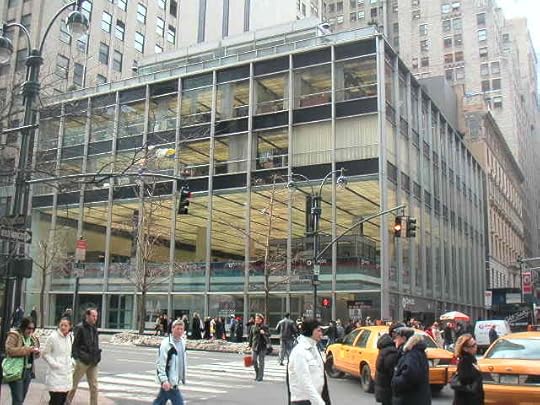
Next week, a post on Gardens: how I raided Mrs. Pierce's tulips; the Bower of Bliss; golden apples; how snakes are beautiful (unless you've got a cobra in your garden); how the Garden of Eden may have been located in Missouri or upstate New York; an apple you can crawl through; Bo Peep and Casanova in Brooklyn; and the wonders of the BBG. After that, though not necessarily in this order: Steamboat Wars on the Hudson (with a glance at today's robber barons); Farewells (with a look at green coffins, and a high school girlfriend who dumped me recently); and Earth Goddesses: Big Mama (ancient and contemporary -- they're all over the place!). Meanwhile, best wishes to all!
(c) 2013 Clifford Browder
Published on April 14, 2013 05:36
April 7, 2013
55. Silence
It is all around us, we are immersed in it, and it is deep within us as well. We come from it, and we will return to it. It has no beginning or end, was there before the appearance of things. It is immediate yet distant, being close to us yet stretching infinitely with no boundary, no end. It is useless, can't be exploited, can't be made to produce anything, can't bring us any tangible profit. It just is, and we need it, crave it, though some of us are scared, even terrified, of it.
Silence has always fascinated me. I have aspired to it for meditation and yoga, have needed it for writing, have treasured it in and for itself. Not that I'm a silent person; on the contrary, life's vicissitudes -- misplaced files, crumbling plaster, computer glitches, junk mail, telephone solicitations --make me mutter, rant, and rage. But then I calm myself and retreat -- for a while -- into at least a semblance of silence. Very well, but then you may well ask, How can you even talk about silence, if you live in a big city in the very midst of the urban cacophony? It isn't easy. Every day I'm serenaded by sirens in the street below. There are three kinds:
Wowwowwowwowwowwow
eeeeaaooouuuu
BigDealBigDealBigDeal
 Our noisy guardians on the job.
Our noisy guardians on the job.Krokodyl
Yes, they're all rushing to save someone's life or property, but in doing so they scrape and punch my ears. And if I go out on errands in almost any direction, I encounter construction, street repair crews, and Con Edison's merry gangs with their posted motto: "Dig we must for a better New York." God knows New York can use some improvements, but these improvements are ubiquitous and noisy, and they never seem to end. Sidewalks are blocked off, huge machines lurch back and forth in the street, and jackhammers serenade passersby with a rattattattattattat that drives many of us to the other side of the street. As for the subway, I won't even try to describe its screeches. I have often asked myself, What are the values of a society that has put a man on the moon but never bothered to muffle a jackhammer?
 My enemy at work. Notice the passerby
My enemy at work. Notice the passerbycovering her ears. Obviously, it's the urban cacophony that makes me prize silence and yearn for it, though I think our need of it is universal, familiar even to inhabitants of small towns and the country. Why else do we flock to nature, a great reservoir of silence, whose soft sounds in no way impair silence but only enhance it: cricket chants on summer nights, the flutelike song of a wood thrush hidden in spring woods, even the croaks and twangs of frogs. (I love those guys, yet hear them more than I see them.) But best of all, for me, is the almost complete silence of deep woods, where on windless days there isn't even the rustle of leaves. There is mystery in nature's silence, as for instance the sound of corn growing. On a muggy summer night when conditions are just right, corn can grow one or several feet. (I'm a Midwesterner by birth and love those tall, tassel-topped stalks with their long, floppy leaves, and grew up gobbling corn on the cob with butter running down my chin.) Long ago I heard a recording of growing corn on the radio: faint creaking sounds such as I had never heard before and haven't heard since. Silence enhances the mystery of growth.
 Corn stalks at sunset. Shh... Soon you will hear them growing.
Corn stalks at sunset. Shh... Soon you will hear them growing.Charles Knowles
As for perfect silence -- not even a bird sound or a rustle of leaves -- I have come close to it perhaps only once. Taking an early morning bus along the south rim of the Grand Canyon, I got off at Yaki Point, the trailhead of the South Kaibab Trail, and for twenty minutes gazed at the wonders of the canyon while enjoying near total silence in solitude, the only sound being, occasionally, the faint croak of a distant soaring raven, until a car arrived and unloaded its platoon of visitors. A few days later I took the mule trip down to the Phantom Ranch at the bottom of the canyon, returning the following day to the south rim at exactly the spot where I had had this wonderful and soothing experience, but during the ride I never encountered the magical silence of those precious twenty minutes.
 The view from Yaki Point. What I saw during twenty minutes of almost total silence.
The view from Yaki Point. What I saw during twenty minutes of almost total silence.InSapphoWeTrust
Must one go all the way to the Grand Canyon to experience true silence? No, occasionally one can get a hint of it right here in the city. Years ago a friend and I went to Brooklyn to see a Zen garden temporarily installed near the Botanical Garden. We were greeted by a Japanese lady in traditional garb, who had us remove our shoes and put on slippers that she provided, after which she waved us into the garden. It occupied a small space enclosed by a wall, and we were the only visitors. I knew nothing of Zen gardens and so was surprised to see an expanse of gravel raked carefully into rhythmic lines perhaps suggesting ripples of water, and, jutting up in the midst of it, several rocks resembling islands in a sea. Raked gravel and rocks, nothing else; not even a trace of greenery, of anything organic. At first it seemed stark and bare, but then we began to appreciate the quintessential quality of it, the subtle abstraction, the purity. And the quiet. Whether this was the message we were meant to get, I don't know; but it was a rare experience of silence -- unique, in fact -- in the very heart of the city.
 A Zen garden similar to the one I saw in Brooklyn. Gravel and rocks, nothing else.
A Zen garden similar to the one I saw in Brooklyn. Gravel and rocks, nothing else.Subtle -- too subtle for Westerners?-- and suggestive.
 A Trappist praying. No idle chitchat here.
A Trappist praying. No idle chitchat here.Daniel Tibi
How can one describe silence? It's like trying to describe the color white, which really isn't a color at all but rather the absence of color. So silence is simply the absence of noise. But if some sounds in nature enhance silence and almost approximate it, can't music do so as well? Music can be gentle and relaxing, and surely it can help in healing. With this in mind, after my cancer surgery long ago a friend gave me a CD with soothing music. That music was too oozy-woozy for my taste, but I don't doubt that music can lessen stress. But can it approximate silence? No, I don't think so; even the softest music is, in its discreet way, assertive. Yet there is one exception: Gregorian chants, where the human voice without musical accompaniment becomes quintessentially spiritual. And silence, of course, is spiritual, being the home of deep reflection, meditation, and prayer. The Quakers are famous for using silence as a form of worship; William Penn, who founded the Quaker colony of Pennsylvania, saw speech as folly, and silence as wisdom. In Trappist monasteries conversation is reduced to an absolute minimum, since speech is of this world, whereas silence conveys the mystery of the next.
The art that best conveys the essence of silence is sculpture, which is by its very nature static and colorless; movement and color would distract. Not all sculpture, of course, for some of it conveys movement, passion, excitement -- Bernini's baroque sculpture, for example -- and some of it expresses power and authority, like much of Michelangelo's work. But the figures of saints and apostles flanking the portals of Gothic cathedrals suggest silence and the spiritual; I have devoted much time to them at Notre Dame in Paris and at my favorite of all cathedrals, Chartres. These figures all seem to possess a profound inner peace and impart something of that peace to viewers, if they take the time to look.
 Chartres: the silence and serenity of faith.
Chartres: the silence and serenity of faith.Chartres and Notre Dame in Paris? And before that, the Grand Canyon? Hey, some viewers may remind me, isn't this blog supposed to be about New York? True enough, though I will always allow myself an occasional digression, an occasional excursion to distant places of interest. But there is sculpture aplenty in New York, and some of it deeply spiritual, a repository of silence. Let's return to the Met, paying a dollar or ten dollars or thirty, depending on our mood, our budget, and our chutzpah (see post #52). In the South Asian hall one can find Hindu statues of exquisite sensuality all but juxtaposed with Buddhas of exquisite spirituality. To know both extremes of human experience says a lot about the culture and people of India. But the Buddhas -- like Buddhas anywhere -- convey the world of silence, the deep spirituality that characterizes all the world's great religions.
 Hindu sensuality: a dancer.
Hindu sensuality: a dancer.Rosemania
 Even headless, a Buddha
Even headless, a Buddhabreathes serenity.
Sailko
Is silence antisocial? By its very nature, yes, being the opposite of babble and bustle. It is hard to avoid the equation civilization = cities = noise. I have often celebrated the excitement and dynamism of New York, and by extension that of the nation. We have always believed in Progress, in the virtues of grab, get, and go. Even the great revival meetings of the past were known less for silence than for soul-wrenching and rather noisy convictions of sin, followed by a great hullabaloo of conversion and joyous celebration. If some of us at times today feel the yearning for silence, we obviously feel a lack of something in all this blatant to-do, a recognition of a deep spiritual need that can be satisfied in various ways, depending on our beliefs ... or lack of them: by God, Nature, meditation, poesy, music, dance, art, this or that sect, this or that guru, religions old or new. This country has always been fertile in new religions -- as in new ideas, new lands, new cities, new industries, new gadgets (clothespins, the telephone) -- so our spiritual needs will surely be met, whether by new modalities or old. And so, wishing everyone just the kind of silence they need, and with all those options in mind, I will end this post with a whisper.
 Ganeshxever
Ganeshxever
 Andreaguidolin67
Andreaguidolin67 Iablock
Iablock Simon Eugster
Simon Eugster Bobover1
Bobover1 Antonio Melina/Agência Brasil
Antonio Melina/Agência Brasil

 Scottari
Scottari

 Steve Jurvetson
Steve Jurvetson Vaishsnava 108
Vaishsnava 108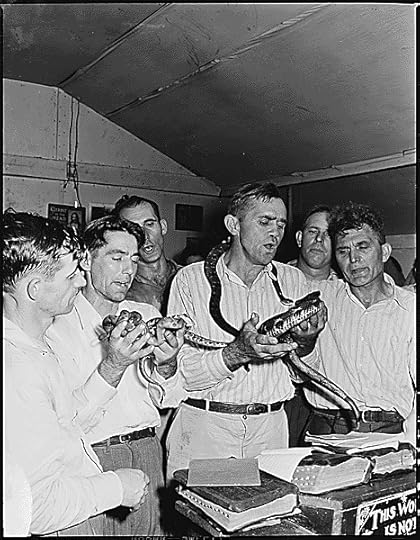


om shanti
pax vobiscum
shalom
Allahu Akbar
And may the universe smile upon you
Coming soon: Monumental New York 2, Steamboat Wars on the Hudson, Farewells, Earth Goddesses: Big Mama, Gardens.
(c) 2013 Clifford Browder
Published on April 07, 2013 05:26
March 31, 2013
54. New York and Water: Steam
The days of sail have been romanticized by later generations (think of all those movies with white sails puffed by the wind), and in many ways those distant days were glorious (see post #48), but they were full of perils too. If a vessel making for the port of New York was driven off its course by wind or waves, it was destined to run aground on the sandbars of either Long Island or New Jersey, since there was no other harbor in the area. Often as not the captain informed passengers that, barring a miraculous change in the weather, the ship was doomed, and those aboard could only watch helplessly as they were slowly driven shoreward, until the elements’ relentless pounding of the stranded ship broke it up within sight of land. Some survived, some didn’t. Such wrecks were a windfall for the local farmers, who quite legally could harvest flotsam and jetsam, or even board the abandoned ship to salvage some of its cargo. (Flotsam: parts of a wrecked ship, or goods from it, found floating in the sea. Jetsam: goods thrown into the sea to lighten an imperiled vessel, or such goods when washed ashore.) One only hopes that the eager salvagers paid due respect to any bodies likewise washed ashore.

Then too there were the frequent losses of sailing vessels in the distant open seas, often with no trace of them ever found. When news of such a loss reached this maritime city, it spread quickly, sowing a somber stillness laced with anguish, fear, and grief. Sometimes the loss of life was known at once, but often, in that age before the telegraph, those concerned had to wait for days or weeks to know if friends or family had survived.
Given such disasters, not to mention the slowness of sail, is it any wonder that New York City, the Hudson Valley, and in time the whole nation and the world hailed the advent of steam in navigation? We’ve all been told how in 1807 Robert Fulton’s vessel, the North River Steamboat (later known as the Clermont), carried passengers the 150 miles from New York to Albany in only 32 hours. A mere 32 hours!

The Clermont, primitive when compared to the palace steamboats of a later day (see
the Commodore below), but the first successful commercial steamboat and therefore
the forerunner of them all.
Yes, today one can do it by bus in less than two hours, but since the sloops then operating on the river (again, see post #48) could take as long as three days, this event immediately revolutionized navigation on the Hudson and fired up this country’s passionate belief in Progress, our obsession with Bigger, Better, and Faster, a mania that gripped us throughout the whole nineteenth century and beyond. (Obsession? Mania? If you think I'm exaggerating, just consider our eager embrace of high-speed Internet, and our frantic gobbling at fast food restaurants.) Thanks to steam, now at last we empowered mortals could, within limits, master wind and waves, and reduce travel time by hours, days, and weeks.
That steamboats would ply the North River, as the Hudson was then called, was almost inevitable. When federal and state courts in 1824 and 1825 annulled the monopoly on state waters that the state legislature had granted Fulton, his financial backer Robert Livingston, and their heirs, all New York City’s waterways were opened up to independent operators eager to grab their share – and more – of the freight and passenger business on those waterways. Improvements in steamboats followed quickly. (All advocates of free enterprise may at this point utter a cheer.)
Historical footnote: The Dutch of New Netherlands referred to the North River (the Hudson), the East River (the same as today), and, at the southern limit of their colony, the South River (the Delaware). The use of “North River” persisted well into the second half of the nineteenth century.
To enter steamboating did not require vast sums of money or even knowledge of the trade. A few enterprising gentlemen could pool their resources and hire a seasoned skipper who would obtain a boat for them and then acquire a crew. If the enterprising gentlemen operated their vessel on a neglected but well patronized route, huge profits resulted and everyone involved was happy. Until, of course, another bunch of enterprising gentlemen, noticing those profits, likewise acquired a boat and ran it in competition with the first bunch. Since the small capitalists of the day were amply endowed with the traditional Yankee virtues of initiative, energy, and greed, all the city’s waterways were soon aboil with cutthroat competition; wild times followed.

The Commodore, named for the owner, whose ego required that numerous river
and seagoing craft be named for him. A typical Hudson River steamboat of the
1840s, with engine and paddle wheels amidships, and twin funnels belching dark
smoke by day, and dazzling patterns of sparks by night. The flags, including one
bearing the boat's name in outsized letters, are exaggerated in size, though
Vanderbilt would not have objected.
There was just one drawback to the new technology of steam: the boilers had a way of exploding, sometimes hurling victims from one township or even one state to another. One such mishap occurred on June 7, 1831, when the General Jackson, plying between New York and Peekskill, blew up in Haverstraw Bay, killing seven or eight and scalding many more. The captain, Jake Vanderbilt, was on shore at the time and so survived unscathed, reportedly exclaiming, “Ain’t I a lucky dog!” Then, leaving the scene of the disaster and the bodies of the dead and injured, he hopped aboard another boat bound for New York so as to find a replacement for his vessel and not lose the route to a competitor. Word of this spread quickly; at the thought of his callousness and greed, all throughout the Lower Hudson indignation boiled. When Jake showed up at Peekskill in another boat the following day, the citizens refused to let him dock and even graced him with a rich harvest of pelted eggs.
Convinced as well that Captain Jake had long overcharged them, the citizens of three counties now formed a joint stock company and acquired a sleek new vessel, the Water Witch, and put it on the run. But who could oversee its daily operation? Wanting someone residing in the city, known to them, and money-wise, they turned to Dan Drew, a onetime cattle drover who now ran the Bull’s Head Tavern, the city’s cattle market, where drovers and butchers met to do business. Drew by aroma alone could tell sheep dung from cattle droppings, but knew little of steamboats, their walking beams and engines. Still, being an enterprising fellow with a keen nose for profits and excitement, he agreed.
The Water Witch was a typical Eastern river boat, a long, narrow sidewheeler adapted to sheltered waterways and built for speed, with a wood-consuming boiler and two towering funnels amidships, a sleek aristocrat beside which the freight-laden, clumsy sternwheelers of the Mississippi Valley looked like wedding cakes mounted on a scow. The first sight of it on the New York-Peekskill run, its funnels belching smoke and its paddle wheels churning, gladdened the citizens of three counties, as did its modest fare. Good riddance to Jake Vanderbilt, that callous gouger!
Ah, but the Vanderbilt clan had no intention of abandoning so lucrative a route. Though Jake Vanderbilt passionately denied the lucky-dog story, his older brother Cornelius, also a steamboat operator, advised him to avoid further harvests of eggs by switching his talents to Long Island Sound, while he, Cornelius, ran his Cinderella to Peekskill. This was the first meeting of Vanderbilt and Drew, who would be friends and enemies, allies and rivals over the next forty-six years.
 Vanderbilt the shipowner, before he went into railroads.
Vanderbilt the shipowner, before he went into railroads.Would you want to mess with this man? The son of a Staten Island farmer, Cornelius (not yet Commodore) Vanderbilt had started out ferrying passengers from Staten Island to Manhattan, soon acquired several sailing vessels that he operated profitably until, becoming convinced that “b’ilers” had it over sails, he sold those vessels and learned the steamboat business. Now, as his Cinderella competed with the Water Witch, he often met Drew on the docks. Tall, handsome, erect, striking in speech and manner and richly profane, Vanderbilt was a big-boned, rangy fellow with great physical presence and an air of potency. Drew, on the other hand, though tall as well, was a quiet, thin-voiced man with a dark complexion, plain, low-keyed, reserved, and as devious and unobtrusive as his opponent was direct, forthright, and bold. Unlike Vanderbilt, he had never “wrastled” in his youth, and to Vanderbilt’s four sons and nine daughters (who kept his wife busy while their pa dallied with other women on the side) could at this point muster only a single daughter. Quickly they sized each other up. A veteran of twenty years on the water, Vanderbilt could not believe that this cattle-driving, tavern-keeping landlubber knew what he was about.
“Drew,” he said more than once, “you have no business in this trade. You don’t understand it and you can’t succeed!”
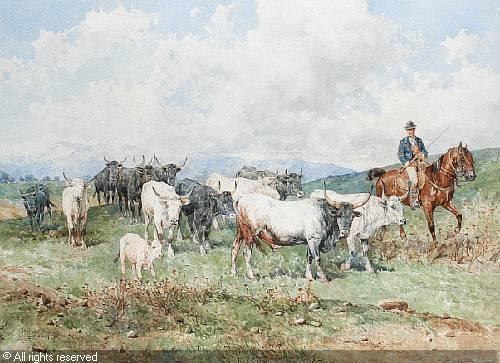 This was Dan Drew's background. But did it prepare
This was Dan Drew's background. But did it prepare him for operating a steamboat?
Source note: In spite of the words "All rights reserved," this illustration is in the public domain.
Daniel Drew was not used to being told he couldn’t succeed. If this big-limbed wharf rat wanted a fight, he would give it to him. Relentlessly he slashed his rates, forcing Vanderbilt to do the same, until by October both boats were carrying passengers at only twelve-and-a-half cents a head. Meanwhile in newspaper ads he and his allies described the Vanderbilts as outsiders, monopolists, and rate gougers. The result: while the Water Witch carried three hundred to six hundred passengers daily and was greeted by cheering crowds at every landing, the Cinderella carried only twenty or thirty, and at times a mere solitary patron, a friend of the Vanderbilts, who hid from the hostile gaze and jeers of the locals. Now, when he met Drew on the docks, Vanderbilt had to admit that the ex-drover had a head for business and evinced an obstinacy that matched his own. With the rates now so low that neither boat could cover its costs, he told Drew that, in the name of good sense alone, Drew ought to abandon the route. But Drew refused.
Both boats ran to the very end of the season, until ice blocked the river in December. All the Lower Hudson rejoiced: the monopoly had been beaten, and Daniel Drew, who promised to resume service at the opening of navigation, was a hero. The Water Witch’s patrons anticipated another season of cheap, safe, speedy transportation.
In March of 1832, when the river ice broke up and service between New York and Peekskill resumed, those patrons were dumbfounded: no Water Witch appeared, but instead the Cinderella, charging the much higher rate prevailing before the competition. With no rival boat in sight, with heavy heart and keen misgivings they had to give their business to the enemy. Further amazement was wreaked upon them when, in April, the Water Witch reappeared at last, but running on another route, and in the service of none other than Cornelius Vanderbilt. The local citizens were beside themselves with rage and dismay. What had happened?
 This (plus Vanderbilt's aura) is what enticed Drew. No U.S. currency yet, just
This (plus Vanderbilt's aura) is what enticed Drew. No U.S. currency yet, just bank notes, but the New York bank notes were highly esteemed.
Over the winter Drew had parlayed secretly with Vanderbilt. Both men being weary of the battle and what it was costing them financially, they had reached an understanding. But would Daniel Drew would give up the route, betraying the trust invested in him by the citizens of three counties, for the sake of mere money? For a lot of it, you bet! And for the same reason he even placed his boat at Vanderbilt’s disposal. A canny, hard-headed businessman, he had weighed the advantages of an alliance with his enemy against loyalty to the citizens of three counties, and found the latter sadly deficient. He was dazzled by Vanderbilt’s imposing presence and overbearing ego, in comparison with which mere ordinary mortals paled to irrelevance. To know such a man, to walk in step with him and be greeted by him as “Dan’l” was inspiring. And if those he had betrayed confronted him, he could rightly insist that all he had done was legal; if they persisted, tracking him down at the Bull’s Head, he could dismiss them, saying that attending to several hundred head of cattle, and a noon meal for hungry butchers and drovers, gave him little time for accounting. And when the Bull’s Head meal bell rang, God help any intruder caught between a stampeding horde of famished diners and the vittles awaiting them.
Even in evangelized, church-going America, “smartness” – shrewdness in business pushed to the limits of legality and honesty, if not a good bit beyond – was universally admired as essential to the twin imperatives of Go Ahead and Get More. Mrs. Trollope had complained of it, as did Charles Dickens, who on his first visit to America often asked why men known to be “dishonourable, debased, and profligate” were tolerated and abetted by the citizens, invariably eliciting the answer, “Well, sir, he is a smart man.” Dan Drew, whether dickering over cattle at the Bull’s Head, or operating a steamboat, or later manipulating stocks on Wall Street, gave evidence of being a very smart man. (Such “smartness” is of course a relic of the past, being universally condemned today in our fair land, is it not? Only WBAI would claim otherwise, and they are notorious nay-sayers and carping critics.)
So ended the Water Witch war, showing what happens to small fry when the big fish get together. Yet this was just a rate war with no mayhem involved, no ramming of one boat by another, just a little bit of treachery and betrayal, and as such tame by the standards of the day. A future post will afford glimpses of steamboat wars that were a bit more – to use words of the time – rambunctious, rampageous, and robustious.
Banknote: I shan't bore viewers with further protestations of the love I bear my bank, J.P. Morgan Chase, in its hour of trial, when it is assailed by the slings and arrows of outrageous fortune. I will only note that, in honor of Easter, my branch now features a small table laden with four (yes, four!) kinds of candy, one of them simulating Easter eggs, as well as an Easter bunny and three big colored balloons. All this, in addition to free pens and coffee, and a hand sanitizer. But who would ever have associated the biggest bank in the country, headquartered in a towering Park Avenue high-rise, with an Easter Bunny surrounded by colored eggs?
 Americasroof
Americasroof
 Emmuhl
EmmuhlFollow-up to post #52: One of my regular viewers has informed me of a lawsuit against the Metropolitan Museum over its allegedly voluntary admission fee, the subject of the middle section of post #52. The story has also been covered in the Times and is well worth following.
http://www.huffingtonpost.com/2013/03/25/metropolitan-museum-accused-of-duping-visitors-on-fees_n_2947478.html?utm_hp_ref=arts
 Ventdorage Follow-up to post #25: Our doctor just told us of a case that recalls post #25, Home Care: The Human Component (Sept. 16, 2012), where I conveyed stories told us by nurses and therapists about difficult and harrowing cases. While visiting us he got a phone call from a man of 87 who is now the legal guardian of his partner, age 81, who has been disabled by a stroke. The older partner is very precise about how he wants the home care aides to do things, and when he had words with one of them, she stalked out in a rage. The next thing he knew, two policemen were at the door who barged in and took the patient, his partner of fifty years, away without any explanation whatsoever. Since then the older partner has tried in vain to locate his friend and in desperation informed the doctor. The doctor thinks that the policemen were sent by Adult Protective Services, an agency that deals with reported instances of elder abuse. Another aide once accused the older partner of abusing the younger one, but since the doctor found no physical evidence of such, he viewed the charge with skepticism. As for the latest crisis, he thinks the authorities' intervention totally unwarranted. Similarly, I've heard stories of social workers threatening to take children away from their parents, if the parents refuse to vaccinate the kids or otherwise depart from accepted procedures. Does the nanny state have to become Big Brother? Apparently. We hope to get updates on the doctor's story, which is troubling in the extreme.
Ventdorage Follow-up to post #25: Our doctor just told us of a case that recalls post #25, Home Care: The Human Component (Sept. 16, 2012), where I conveyed stories told us by nurses and therapists about difficult and harrowing cases. While visiting us he got a phone call from a man of 87 who is now the legal guardian of his partner, age 81, who has been disabled by a stroke. The older partner is very precise about how he wants the home care aides to do things, and when he had words with one of them, she stalked out in a rage. The next thing he knew, two policemen were at the door who barged in and took the patient, his partner of fifty years, away without any explanation whatsoever. Since then the older partner has tried in vain to locate his friend and in desperation informed the doctor. The doctor thinks that the policemen were sent by Adult Protective Services, an agency that deals with reported instances of elder abuse. Another aide once accused the older partner of abusing the younger one, but since the doctor found no physical evidence of such, he viewed the charge with skepticism. As for the latest crisis, he thinks the authorities' intervention totally unwarranted. Similarly, I've heard stories of social workers threatening to take children away from their parents, if the parents refuse to vaccinate the kids or otherwise depart from accepted procedures. Does the nanny state have to become Big Brother? Apparently. We hope to get updates on the doctor's story, which is troubling in the extreme. Coming soon: Silence (with a brief glance at new religions), more monuments, farewells, steamboat wars, and who knows what else.
(c) 2013 Clifford Browder
Published on March 31, 2013 05:15
March 24, 2013
53. Monumental New York
New York City is monumental. By this I mean that the whole of it is vast and imposing, but also that it harbors many individual monuments. By “monument” I mean structures that are likewise vast and imposing, but also structures that, while smaller, are impressive for reasons aesthetic or historical. Clearly, this takes in a lot, and I may even cheat a bit by throwing in a bridge or two. So let’s take a walking tour though Manhattan, zigging here and zagging there to the sites of my favorite New York monuments, some vanished, some still with us. My choice is personal and subjective; viewers should feel free to differ, or even remonstrate or upbraid. I’m tough, I can take it. At least, I think I can. So here goes. First a panoramic glimpse, to catch the effect of early morning light on tall buildings, and then specifics.
 AngMoKio
AngMoKioI have already mourned the demolition in 1964 of the old Penn Station in post #49, but I must do it again. In part, I am atoning for my neglect of the structure when, hurrying to board a train for Philadelphia or Washington, I had no time for architectural grandeur. Today, seeing photographs of the interior, I am dazzled by the soaring columns, the majestic arches, the vast enclosed space, the Beaux-Arts classicism of the building, a masterpiece by Stanford White's firm, McKim, Mead, & White. (White himself had been murdered in Madison Square Garden in 1906, four years before Penn Station opened, but that's another story.) As the noted critic Ada Louise Huxtable has said, this was grandeur such as we will never see again.
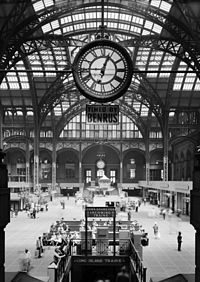 The Concourse, two years before demolition.
The Concourse, two years before demolition.A footnote: Madison Square Garden seems to have jinxed Stanford White. Not only was he killed there, but years later the coming of another Madison Square Garden led to the demolition of his masterpiece, Penn Station.
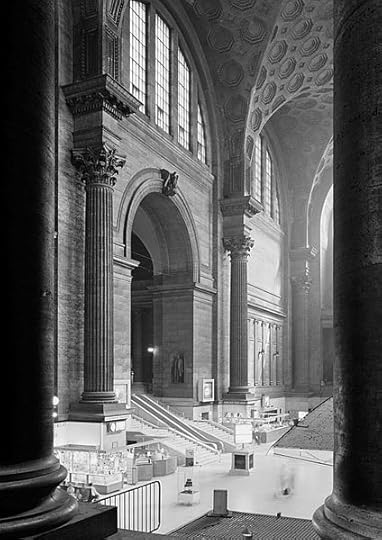 The waiting room, 1962.
The waiting room, 1962. And then ... nyc-architecture.com
And then ... nyc-architecture.comBidding farewell for the moment to classicism, let’s take a look at the Gothic. The Gothic in New York? Well, neo-Gothic. Coming back on West 4th Street from a bargain wine store with a stash of cheap – no, let’s say modestly priced – wines, when crossing Broadway I look downtown and see the Woolworth building, a Gothic skyscraper, and looking uptown I see Grace Church, also Gothic. I love both. (But I allow myself only a glimpse of each. One doesn't linger. This is, after all, New York. When the light changes, you could get flattened by traffic.)
 Urban Erected on lower Broadway near City Hall in 1913 as the corporate headquarters of the Woolworth company, the 57-story Woolworth building was then the tallest building in the world, and remained such until the Chrysler building surpassed it in 1930. Its interior is said to be sumptuous, but I have never been in it and know it only from a distance, where its soaring summit is visible. But it’s that soaring summit that I love, for that’s where the neo-Gothic ornamentation is concentrated: spires, pointed windows, flying buttresses, turrets, lacelike tracery, and gargoyles – detail that only birds can fully appreciate. In 2012 it was announced that the top floors will be turned into luxury condominiums, including a five-story penthouse in the cupola -- disconcerting news to the building’s fans, though presumably the exterior will not be affected. Imagine living up there with the gargoyles and a panoramic view of New York or New Jersey! Marvelous, as long as no strike by the building’s staff – or a hurricane -- shuts down the elevators.
Urban Erected on lower Broadway near City Hall in 1913 as the corporate headquarters of the Woolworth company, the 57-story Woolworth building was then the tallest building in the world, and remained such until the Chrysler building surpassed it in 1930. Its interior is said to be sumptuous, but I have never been in it and know it only from a distance, where its soaring summit is visible. But it’s that soaring summit that I love, for that’s where the neo-Gothic ornamentation is concentrated: spires, pointed windows, flying buttresses, turrets, lacelike tracery, and gargoyles – detail that only birds can fully appreciate. In 2012 it was announced that the top floors will be turned into luxury condominiums, including a five-story penthouse in the cupola -- disconcerting news to the building’s fans, though presumably the exterior will not be affected. Imagine living up there with the gargoyles and a panoramic view of New York or New Jersey! Marvelous, as long as no strike by the building’s staff – or a hurricane -- shuts down the elevators. Here is the Gothic ornamentation that I love.
Here is the Gothic ornamentation that I love.Jonathan 71
And now for a different kind of Gothic...
 nyc-architecture.com Grace Church, the Episcopal parish church on Broadway at 10th Street, introduced the Gothic Revival style to New York when it was consecrated in 1846. The architect, James Renwick, Jr., who was just at the beginning of his career, had never seen a Gothic church, but studied illustrations of them intensely. The result was a marvel of neo-Gothic architecture, with a marble exterior and a stonelike plaster interior. (Sing-Sing inmates cut the marble used in its construction.) But if the exterior is impressive, the interior, an oasis of calm so close to turbulent Broadway, is a marvel also. In no time Grace Church became the most fashionable church in the city, and to have your marriage ceremony or funeral service conducted in those hallowed precincts was considered the height of felicity. Officiating there for many years was Isaac H. Brown, sexton extraordinaire, who when not serving as the gatekeeper, deigning to lead suppliant visitors to a vacant pew on the Sabbath, was decreeing the latest indispensable elements of a fashionable funeral, adornments that might vary from year to year and that only he could determine. (See post #32.) Today the beauty of the interior is undiminished. Added later, the rectory and chantry are in the same neo-Gothic style.
nyc-architecture.com Grace Church, the Episcopal parish church on Broadway at 10th Street, introduced the Gothic Revival style to New York when it was consecrated in 1846. The architect, James Renwick, Jr., who was just at the beginning of his career, had never seen a Gothic church, but studied illustrations of them intensely. The result was a marvel of neo-Gothic architecture, with a marble exterior and a stonelike plaster interior. (Sing-Sing inmates cut the marble used in its construction.) But if the exterior is impressive, the interior, an oasis of calm so close to turbulent Broadway, is a marvel also. In no time Grace Church became the most fashionable church in the city, and to have your marriage ceremony or funeral service conducted in those hallowed precincts was considered the height of felicity. Officiating there for many years was Isaac H. Brown, sexton extraordinaire, who when not serving as the gatekeeper, deigning to lead suppliant visitors to a vacant pew on the Sabbath, was decreeing the latest indispensable elements of a fashionable funeral, adornments that might vary from year to year and that only he could determine. (See post #32.) Today the beauty of the interior is undiminished. Added later, the rectory and chantry are in the same neo-Gothic style. nyc-architecture.com
nyc-architecture.com The rectory, built in 1846-47 by Renwick.
The rectory, built in 1846-47 by Renwick.Beyond My Ken
Next, let’s have a look at City Hall, which opened in 1812 and has been altered many times since. It consists of a central pavilion with two wings, the exterior being French Renaissance, and the interior, American Georgian. The structure is topped by a cupola, which is topped in turn by a copper statue of Justice that few visitors, alas, are even aware of. The building’s original marble deteriorated and therefore had to be replaced with limestone and a granite base in the 1950s. Even so, it is a small architectural gem from another age, albeit dwarfed by the bigger buildings surrounding it. The front steps leading up to the portico have been the scene of many a press conference and rowdy demonstration.
 Momos
Momos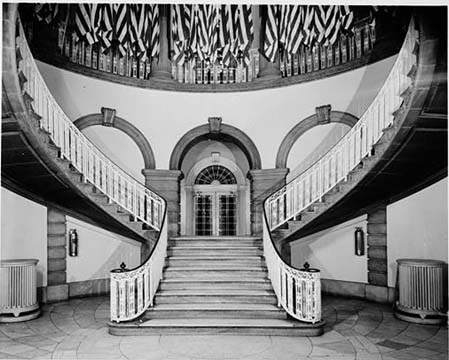 nyc-architecture.com
nyc-architecture.comInside, a grand marble staircase leads to the second floor, where Corinthian columns support the dome of a vast rotunda. Abraham Lincoln once lay in state here, so citizens could file by the coffin to pay their respects. Later, Ulysses S. Grant also lay in state.
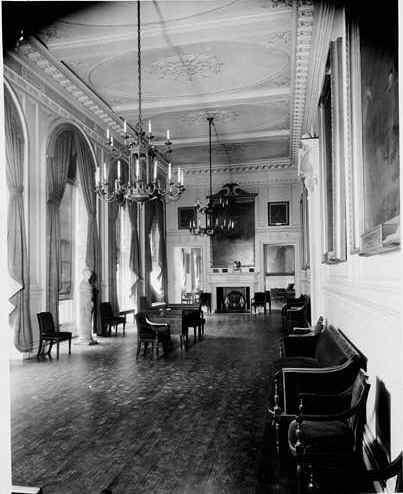 The Governor's Roomnyc-architecture.com
The Governor's Roomnyc-architecture.comSmall as it is by today’s standards, City Hall still houses the mayor’s office and the chamber of the City Council. The city’s bureaucracy being surpassed in size only by the federal government (Libertarians can comment here), the city’s many agencies are housed in the huge but rather drab Municipal Building nearby, a labyrinth in which I once got lost while looking for the City Archives. The Blue Room is used for press conferences, where the mayor answers or evades reporters’ questions, and also for bill-signing ceremonies, so as to prove to voters that yes, sometimes, something can get done. On the second floor the elegant Governor’s Room houses an important collection of nineteenth-century American portraiture and is used for formal receptions.
Next, we’ll trek far uptown to the Morningside Heights campus of Columbia University, which is dominated by another Stanford White masterpiece, the Low Memorial Library. Built in 1895, it was named by University President Seth Low for his father. The neoclassical structure is in the shape of a Greek cross and incorporates elements of the Pantheon in Rome. The first building completed on the new campus, it originally housed the university’s library, but today is occupied by administrative offices. If I emphasize its grandeur now, I’m making up for the years of neglect when, a graduate student in the 1950s, I was too preoccupied with studies and campus social life to give this magnificent structure its due. Attention of another kind came in the spring of 1968, long after I had departed the campus, when radical students occupied the building, and most specifically the office of the university president, and were blockaded there by other students opposed to the rebellion, until the occupiers were expelled by the police. Surviving this and other vicissitudes, Low Library is still the focal point of the campus, its domed majesty and columned front unforgettable.
 InSapphoWeTrust
InSapphoWeTrust InSapphoWeTrust Inside the building is a surfeit of classical busts, including one of Athena, goddess of wisdom, presumably to inspire inquisitive young minds. But the campus statue that I particularly remember is a bronze copy of Rodin’s The Thinker, in front of Philosophy Hall, where I attended many classes. It is impressive and I and other students did take note of it, but to us it seemed like he was engaged in an activity less cerebral than physiological.
InSapphoWeTrust Inside the building is a surfeit of classical busts, including one of Athena, goddess of wisdom, presumably to inspire inquisitive young minds. But the campus statue that I particularly remember is a bronze copy of Rodin’s The Thinker, in front of Philosophy Hall, where I attended many classes. It is impressive and I and other students did take note of it, but to us it seemed like he was engaged in an activity less cerebral than physiological.Another lost architectural gem is the Old Met, the original Metropolitan Opera House, noted less for its Italian Renaissance exterior than for its interior. Before its opening in 1883, operas were performed at the Academy of Music on 14th Street, but the Old Money crowd there excluded the New Money crowd – Vanderbilts and Goulds and such – from the boxes so desired by the elite of society at the time. So what did the New Money folks do? Having plenty of cash and gumption, they decided to build a new and better opera house at a more fashionable location uptown. The result was the Metropolitan Opera House, occupying the entire west block on Broadway between West 39th and 40th Streets. The exterior was criticized from the outset as flat and drab, but the sumptuous interior was praised for its elegance and superb acoustics. I can testify to the latter, having often sat in the topmost Family Circle, where the acoustics were indeed excellent, as long as you didn’t mind being up near the angels and descending perilously to the front row, where only a low railing shielded you from a precipitous drop. The view from the Family Circle in the New Met is likewise dizzying.
 The New Met, as seen from the Family Circle. See why I was nervous?
The New Met, as seen from the Family Circle. See why I was nervous?Andreas Praefcke
In the old days the lower rings were known as the Diamond Horseshoe, being occupied by millionaire patrons whose opera glasses scanned the boxes opposite as readily as performers on the stage. What was the point of attending opera, after all, if not to see and be seen? And what a setting to be seen in! My partner Bob has vivid memories of the Met interior of the 1950s: the red and gold décor, the huge gold curtain, the red velvet seats, and before the performance began, the glow of the women’s jewelry in the soft amber light. For atmosphere and intimacy, the New Met is no match.
 The Old Met in 1888, back when the Horseshoe was really diamonded.
The Old Met in 1888, back when the Horseshoe was really diamonded.The move to Lincoln Center had its advantages as well. In this setting the Metropolitan Opera House is part of an impressive whole. To see the plaza at night with all the buildings illuminated, and the fountain spuming upward, is to witness something magical. On this note I will end -- or almost end -- the walking tour of Monumental New York, though another tour is planned.

The magic of night. The New Met is on the left; Avery Fisher Hall, the home
of the New York Philharmonic, is on the right.
Nils Olander
 Beyond My Ken
Beyond My KenNote: Because buildings that once housed banks in time serve other purposes, monumental façades show up in strange places. At the corner of West 14th Street and Eighth Avenue, not far from where I live, two mini-Parthenons loom impressively, their majestic portals flanked by noble columns. Blazoned high above the entrance of the one on the northwest corner are the riveting words “CVS Pharmacy,” and over the other one on the southwest corner, “Men’s Spa.” So classicism is not dead in this city, though Stanford White and others may be shifting a bit in their graves. A summary of Western civilization: architecture that once housed the presence of the gods, and then the presence of money, now houses aspirin and Clorox and Cheerios. On this happy note, cheerio!
Note re post #52: Last week's post, New York Hodgepodge 2, included a section on the entry fee for the Metropolitan Museum of Art, which is whatever you choose to pay. Friends of mine, all on a tight budget, have paid as little as a dollar or, for two, a dollar fifty. This prompted a comment from Anonymous, an artist also on a tight budget, who so loves what the Met offers that he never pays less than ten dollars. See what he says (and my brief reply) at the end of that post. I encourage comments from viewers and hope to hear from Anonymous again.
Banknote: The onslaught against my bank and its noble CEO continues unabated. Hardly a day goes by without a front-page article in the Times assailing Jamie Dimon and his cohorts, while Congressmen grill him over alleged past misdeeds, none of them, so far as I can tell, illegal. So he lost six billion in a trade. For a Wall Street wizard like Mr. Dimon, a Midas of Moolah, that's pennies. Why should stop-and-frisk apply to big banks, which provide money, the lifeblood of capitalism, to our society? I cannot think ill of him or his bank, when my local branch, in addition to free candy and free pens and a hand sanitizer, now provides a contraption that generates on demand hot coffee or tea. Yes, hot coffee and tea in my bank, which is fast becoming a nest of beneficence! As for those Congressmen, know them for the ingrates they are: Mr. Dimon and other bankers have sweetened their campaign coffers with an abundance of cash, and this is the thanks they get. Which brings to mind again my favorite Occupy Wall Street sign: TODAY ONLY: BUY ONE SENATOR, GET ONE FREE. Such are the times we live in.
Coming soon: Steamboats on the Hudson, more monuments (can't get them all in one post), and a post on farewells and another on the mystery of silence.
(c) 2013 Clifford Browder
Published on March 24, 2013 04:55
March 17, 2013
52. New York Hodgepodge 2.docx
WBAI again: when is the truth too much?
We’ll begin with a horror so as to get it out of the way. This is a follow-up to post #16 – the first post of this blog – published in July 2012: My Love/Hate Affair with WBAI , and to post #50, WBAI -- again! To escape the high rent of their Wall Street studio and its vulnerability to hurricanes and flooding, the station has moved to a safer location farther uptown in Harlem. They are now engaged in another of their interminable fund drives, offering unusual premiums – unusual for any station other than WBAI – to listeners who pledge a certain sum of money. On one program the host was offering a CD documentary entitled “Lynching: An American Tradition.” Several excerpts were presented, telling in graphic detail the mutilations that often accompanied the killing, and emphasizing how these affairs were entertainment for the community, with a ritual aspect. These stories are well documented, leaving little room for doubt, but they are, to put it mildly, gruesome. The host told how one black teacher (I don’t know at what level), when acquainted with the material, announced that under no circumstances would she offer it to her students, lest it cause them to hate white people. But WBAI insists that its mission is to bring light to dark places, and that the most hideous details of our history need to be known.
 Not the Deep South but Duluth, Minnesota, June 15, 1920. A postcard.
Not the Deep South but Duluth, Minnesota, June 15, 1920. A postcard.All of which raises the question whether the truth should always be told, in its entirety, regardless of consequences. In this case I wouldn’t say no, but I have serious reservations. Under what circumstances, and to whom? I think the teacher was right: this is not material for schoolchildren, because it must be absorbed by persons mature enough to acknowledge the facts without being overwhelmed by them – in other words, by adults capable of judgment. History is a bitter pill to swallow, and none bitterer than the lynchings so common in the South – and often too, alas, in the North – between 1890 and 1940. It’s not just the mutilations that shock me, but also the social aspect of these incidents, as registered in photographs that were taken of the participants and witnesses: smiling throngs happy to pose for the photographer, usually men and boys but also at times a sprinkling of women. Some of the photographs even ended up on postcards, which prompts another question: who would send such a postcard, and to whom?
Yes, the lynchings had a ritual aspect, but I also see in them something of an exorcism, a blind and ruthless expulsion of imagined evil, a supposed purification of the threatened community. And all this was a common occurrence – condemned in the North but condoned in the South – well into the enlightened twentieth century. Are we all barbarians and sadists at heart? Reading descriptions like those in the CD, and seeing the photographs taken, one may well think so. Yes, history is a bitter pill to swallow, and it imposes a heavy weight of awareness; not everyone is up to bearing it. With this in mind I have omitted certain other even more shocking photographs -- archived in the Library of Congress, by the way -- and will not focus on such material in the future. WBAI may well criticize such an attitude, but I leave it to them to delve into the most unsavory episodes of our national history and make them known. Facts are facts, but how many of these can we take at one time?
What price the Met?
The Metropolitan Museum of Art in New York is one of the world's greatest museums, harboring marvels from all over the world. (Some of them may have been stolen, but that's another story.) The admission price is $25 for adults, $17 for seniors, and $12 for students -- admittedly, a bit pricey. These prices, however, are recommended -- strongly recommended -- but not obligatory. It's a fairly well-kept secret that one could get in for a penny, though I suspect that not many do. Out-of-town visitors probably pay the full price without question, but savvy New Yorkers, if brazen and thick-skinned enough, know how to play the game. A friend of ours -- we'll call him Jim -- goes monthly and routinely pays only a dollar. This takes courage, for the building itself is majestic and monumental to the point of intimidation, and the vast hall just inside is equally imposing, suggesting a palace of wonders, a citadel of art. Can one really gain entrance to these storied halls by paying only one measly dollar? This is an adventure for the hardy few. Wimp that I am, I have often paid the recommended price, though on occasion I have squirmed in for less. But with the adult price now $25 -- matching that at MOMA (the Museum of Modern Art), where you either pay the price or are denied the riches within -- I don't blame anyone for paying less. Which brings me to a story.
 Wouldn't one be intimidated already, approaching this majestic Beaux-Arts façade on Fifth Avenue
Wouldn't one be intimidated already, approaching this majestic Beaux-Arts façade on Fifth Avenuewith its soaring columns, palatial steps, and flaunted banners proclaiming the marvels within?
Recently a friend of ours -- we'll call her Beth -- came from New England with her grown daughter for a brief visit to the city. They were on a tight budget but determined to see the Met. Hearing Jim talking of getting in for only a dollar, they decided to follow his lead. So they mounted the front steps, entered the vast hall, and approached a guardian of the portals positioned behind her desk and ready to receive the admission price and give the visitor a small badge to be pinned to one's clothing, showing the guards that this person has indeed paid to get in. In front of Beth and her daughter was another woman -- surely a knowing New Yorker -- who forked out a mere fifty cents. Glowering, the guardian of the portals literally flung the badge down on the counter. Beth then stepped up to the counter and put down a dollar and a half. "Is this for both of you?" the guardian asked incredulously. "Yes," said Beth, masking her nervousness with a feeble attempt at brazenness. The woman then gave them two badges, but with such a withering look of derision that Beth winced visibly even when recounting the incident to us later. That look, she assured us, would be with her for days, if not weeks, to come. Moral: Be bold, be brazen when paying less than $25 at the Met. This game is not for the faint of heart.
 The Great Hall. Everything about it -- the uniformed guards, the surging crowds, the vaulting far
The Great Hall. Everything about it -- the uniformed guards, the surging crowds, the vaulting far above, the towering statue on display -- is likewise awesome and intimidating. Would one really
dare to offer only fifty cents or a dollar to enter these world-renowned chambers of magnificence?
WestportWiki
Footnote: The Art Institute of Chicago -- another palace of wonders -- charges adults $25 for admission, seniors $18, and students $14, but offers discounts to local residents: adults who are residents of Chicago pay $23, and residents of Illinois pay $20, with similar discounts for seniors and students. Met, take note. This might help to lessen the one-dollar offerings.
How a nightingale became a cash cow
When she arrived in the city in September 1850, close to forty thousand people jammed the docks to greet her, few of whom had ever heard of her until recently; so great was the crush, bruises and bloody noses resulted. Setting foot on the ground, she kissed her hand to an American flag, announcing, "There is a splendid standard of freedom, worshipped by the aggrieved of all nations." She then further endeared herself to the throng by preventing her coachman from clearing a path through the crowd with his whip. Multitudes followed her to her hotel amid a sea of flags and triumphal arches, bouquets were thrown to her from windows, and some in the crowd fought -- literally -- for a mere glimpse of her. Described in the press as being shy, modest, selfless, and devout, thanks to her publicist she was America's sweetheart already (decades before screen actress Mary Pickford), though almost no one had ever heard her sing. Pictures of her were readily available, showing a lovely, modestly dressed, demure young woman of thirty about whom no taint of scandal could possibly hover -- no sizzling seductress of a diva, no threat to hearth and home, but a sweetheart for even the most moral of citizens.

The visiting celebrity was of course Jenny Lind, the acclaimed Swedish coloratura soprano, and her publicist was P.T. Barnum, the king of humbugs, who in this instance was presenting to the public an attraction that was exactly what he claimed. While touring England with Tom Thumb, whose diminutive presence he had presented to Queen Victoria, the impresario had for the first time heard of Jenny Lind and, noting her appeal to audiences, determined to bring her to America, where her reputation for morality and philanthropy, even more than her vocal accomplishments, would appeal to audiences. Approaching her with Yankee bravado, he offered her $1,000 a night for 150 nights -- an unheard-of sum for the times. How could he hire her without ever having heard her sing, she asked. "Because, Madame Lind," he replied, "I have more faith in your reputation than in my musical judgment."
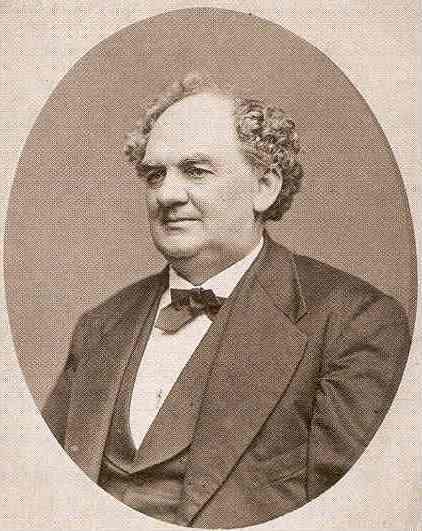
Lind might well have hesitated, had she known more about this man who had popped up out of nowhere. Barnum had hoaxed the public more than once, and is said to have hired the worst band he could find to play on the balcony of his American Museum on Broadway, in the hope that they would drive people into the museum. The museum itself harbored fossil and mineral collections, but also such phenomena as the Feejee Mermaid, a bearded lady who may or may not have been a bona fide lady, and a woolly horse. And he had posted signs reading THIS WAY TO THE EGRESS, so that visitors anticipating another exhibit would proceed to the exit and find themselves out on the street, obliged to pay another admission to re-enter. But these wiles were unknown to her, and she saw a splendid opportunity to raise large sums of money for the Swedish charities that meant so much to her, so she agreed. But the Swedish nightingale proved to be a shrewd businesswoman: she demanded the fee in advance, forcing Barnum to borrow heavily, and insisted on a clause in the contract that gave her the option of withdrawing from the tour under certain circumstances. Barnum was risking all in this venture, but he was sure his instinct was sound, sure that she would charm the nation.
Barnum's advance publicity -- letters to the press, broadsides, biographies -- ensured that, when the singer arrived on these shores, vast numbers of Americans who knew nothing of coloratura singing would deem their lives dull, barren, deprived, and incomplete, unless they viewed this prodigy and, if possible, obtained a ticket to one of her concerts. He accomplished this by putting numerous journalists on his payroll, so that press coverage was constant and enthusiastic. Sponsored by him, a poetry contest produced an abundance of doggerel that even so kept her name before the public. Not to be outdone, merchants produced plates, bottles, figurines, and medals bearing her features. There were Jenny Lind bonnets, gloves, cribs, chairs, sofas, pianos, and even a Jenny Lind sausage and a soup. Newspapers advertised the best engravings of the singer (slightly retouched; photographs showed a fuller, plainer face), and promoted Jenny Lind opera glasses and fans and concert hats. And when a glove of hers was allegedly found in the street, the finder charged others to kiss it: one shilling on the outside, two on the inside. "Lind fever" had swept the country. Boasted Barnum, "Everything was Jenny Lind."
Lind's first concert was to be given in Castle Garden, a former fort at the Battery that had been converted into an exhibition hall, opera house, and theater. Seeing the public's fervor, Barnum auctioned off the first few seats for unprecedented sums; by virtue of being the first purchaser, a New York hatmaker himself became a celebrity. The auctioning distressed Lind, who thereafter persuaded Barnum to offer a substantial number of tickets at reduced prices. Furthermore, seeing the fortune Barnum was bound to realize, she insisted on renegotiating her contract so as to obtain more money for her beloved charities. In this demure, most charitable woman Barnum had found his match.
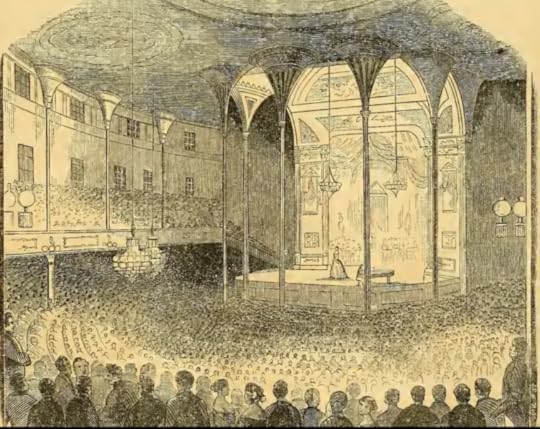 Jenny Lind at Castle Garden
Jenny Lind at Castle GardenLind's first concert at Castle Garden was, to put it mildly, a smash. Not only was the house packed, but those unable to obtain tickets rented rowboats and enjoyed the concert from the water. She sang "Casta diva" from Bellini's Norma, a duet with a baritone, a piece by Meyerbeer that let her perform astonishing vocal feats, and some Swedish songs. When, against her wishes, Barnum appeared on the stage and announced that she was donating her entire fee for the evening to local charities, the resulting shouts and applause were deafening, and many spectators were reduced to tears. Apparently mindful of the women's rights convention at Seneca Falls, New York, in 1848, Washington Irving insisted, "She is enough to counterbalance, of herself, all the evil that the world is threatened with by the great convention of women. So God save Jenny Lind!" The proceeds from this first concert alone were such that Barnum recouped his investment fourfold.
After her two New York concerts Barnum escorted Lind on a tour throughout the country, where "Lind Fever" raged unabated. Her singing, said Barnum in a broadside, would remind one of a mother's love, a sister's kiss, the sinless pleasures of childhood. Be that as it may, his Queen of Song finally tired of his ruthless commercial promotion, and in 1851 invoked a clause in her contract that let her terminate their relationship; they parted amicably, each having realized a fortune. She continued the tour under her own management, and married her pianist/conductor before returning to Europe. As for Barnum, his promotion of her -- his greatest success in a long career with many successes -- is seen by many historians as the beginning of modern advertising. That accomplishment alone, we Americans must surely admit, catapults him to the pinnacle of greatness.
Banknote: Veteran viewers of this blog know the love I have for my bank, J.P. Morgan Chase. And how could it be otherwise, when they give me free pens and candy, and provide a hand sanitizer as well? So I am shocked -- shocked! -- to see this august institution now assailed on all sides. Congress has grilled its executives ruthlessly over so small a matter as a six-billion-dollar loss in trading, and regulators assert that the bank's lending practices are less than reputable. How can this be? Old J.P. would never have stood for it. But I am sure that J.P.Morgan Chase will survive these petty assaults and return to its noble function of manipulating money. The attacks on it are no doubt inspired by envy but, given time, they will vanish like the morning dew.
(c) 2013 Clifford Browder
Published on March 17, 2013 05:00



